High density receptacle
Avery , et al. April 19, 2
U.S. patent number 11,309,655 [Application Number 16/302,225] was granted by the patent office on 2022-04-19 for high density receptacle. The grantee listed for this patent is Molex, LLC. Invention is credited to Hazelton Avery, Kent E. Regnier.
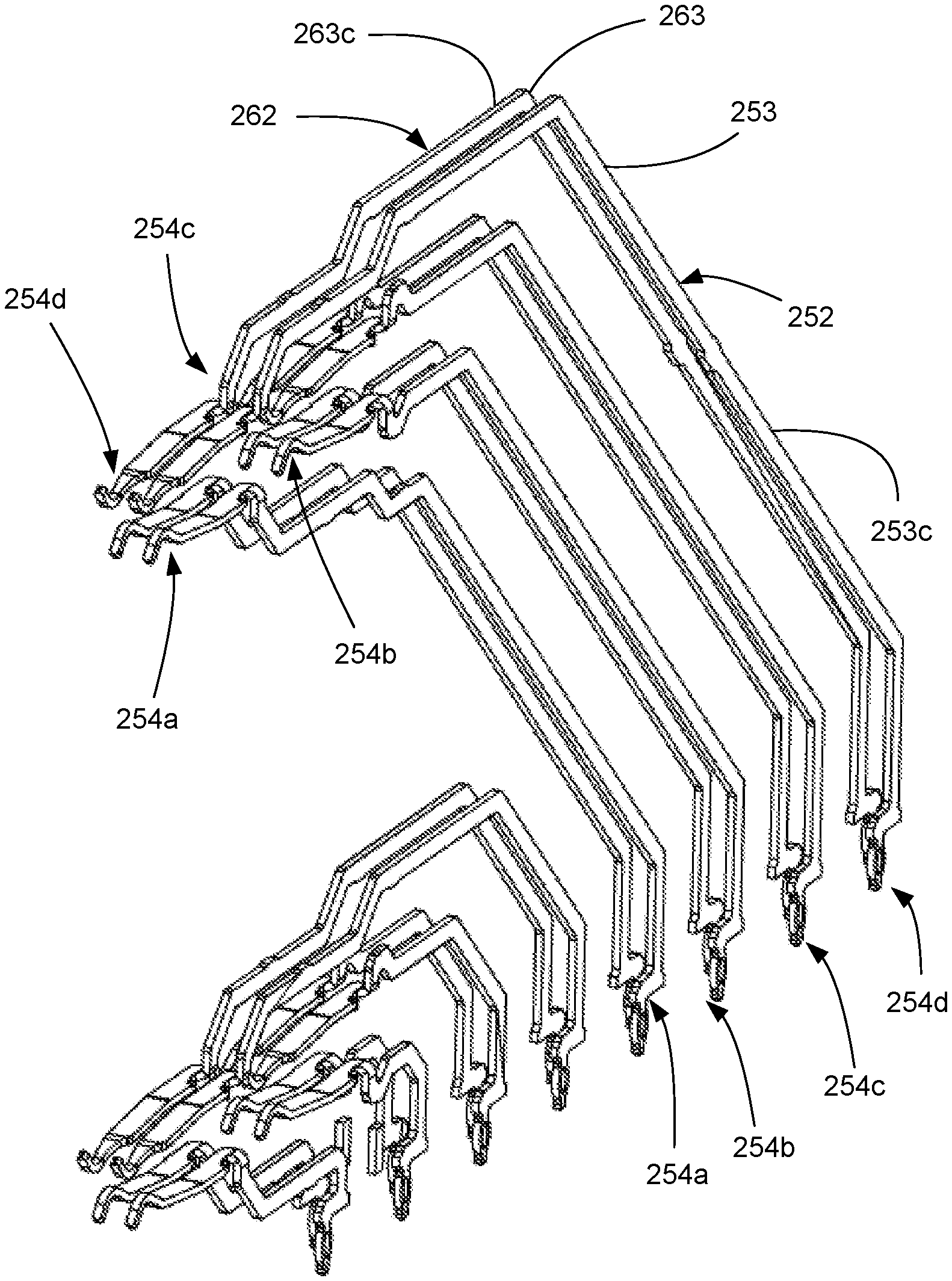
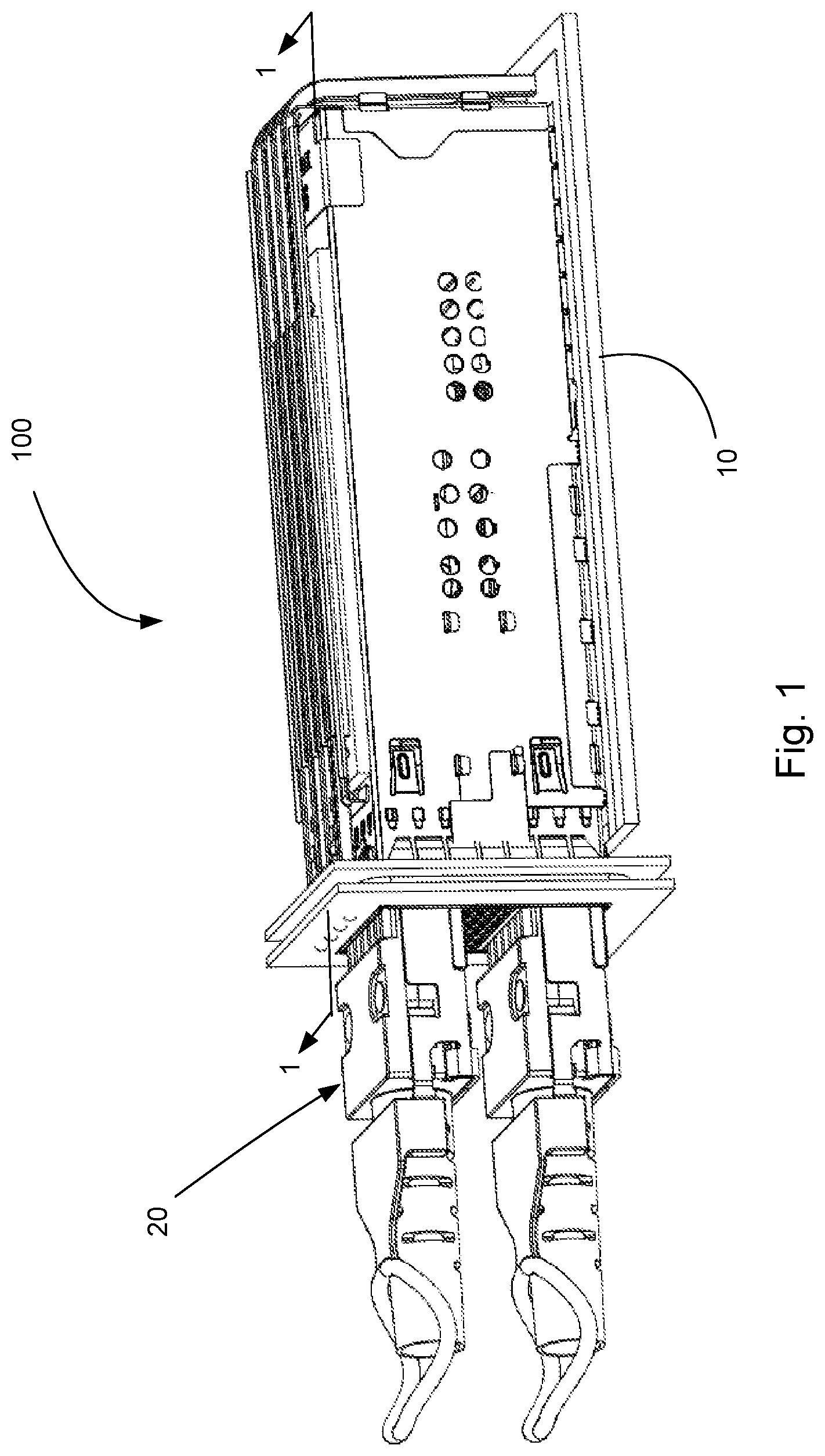
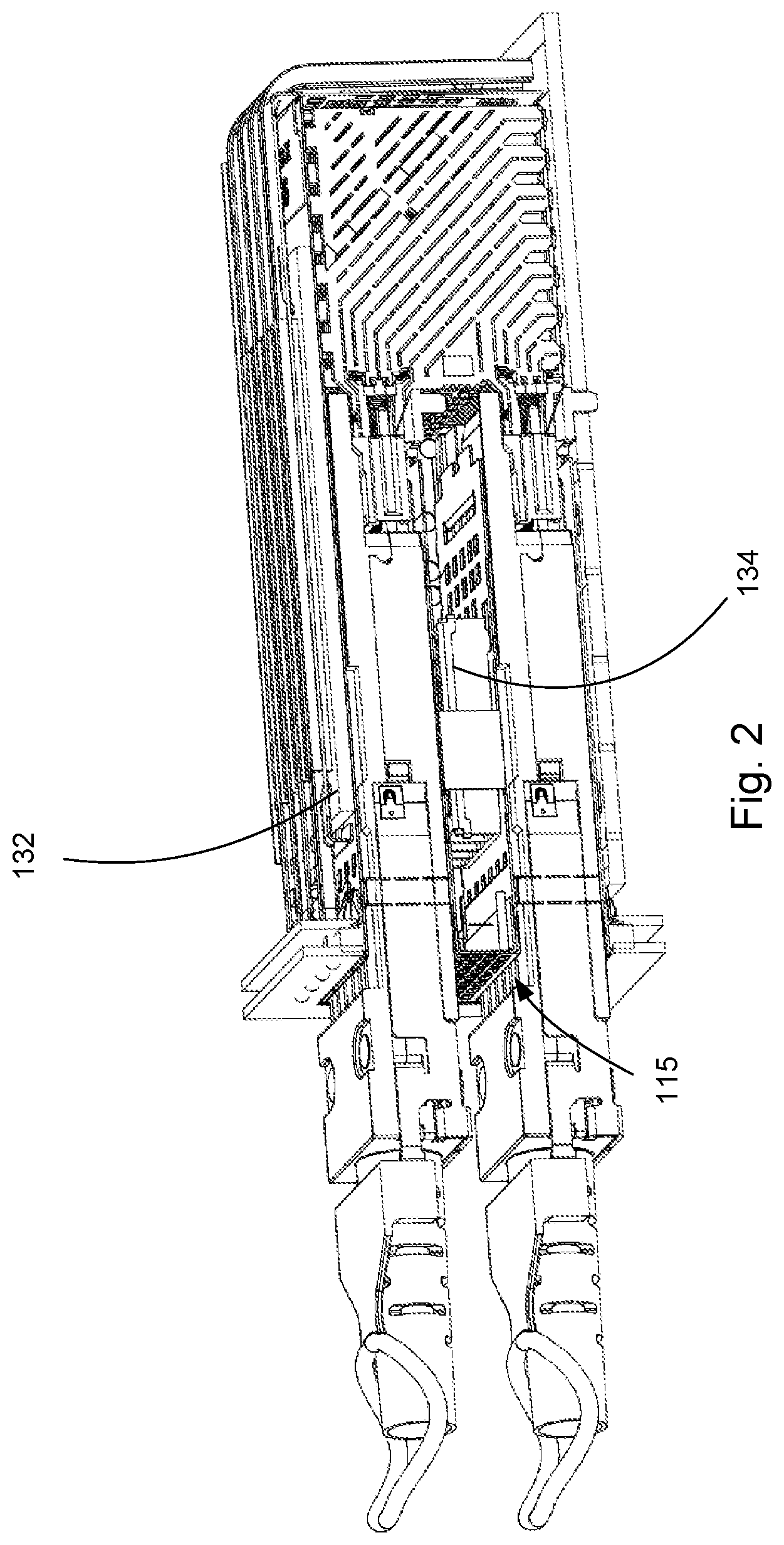
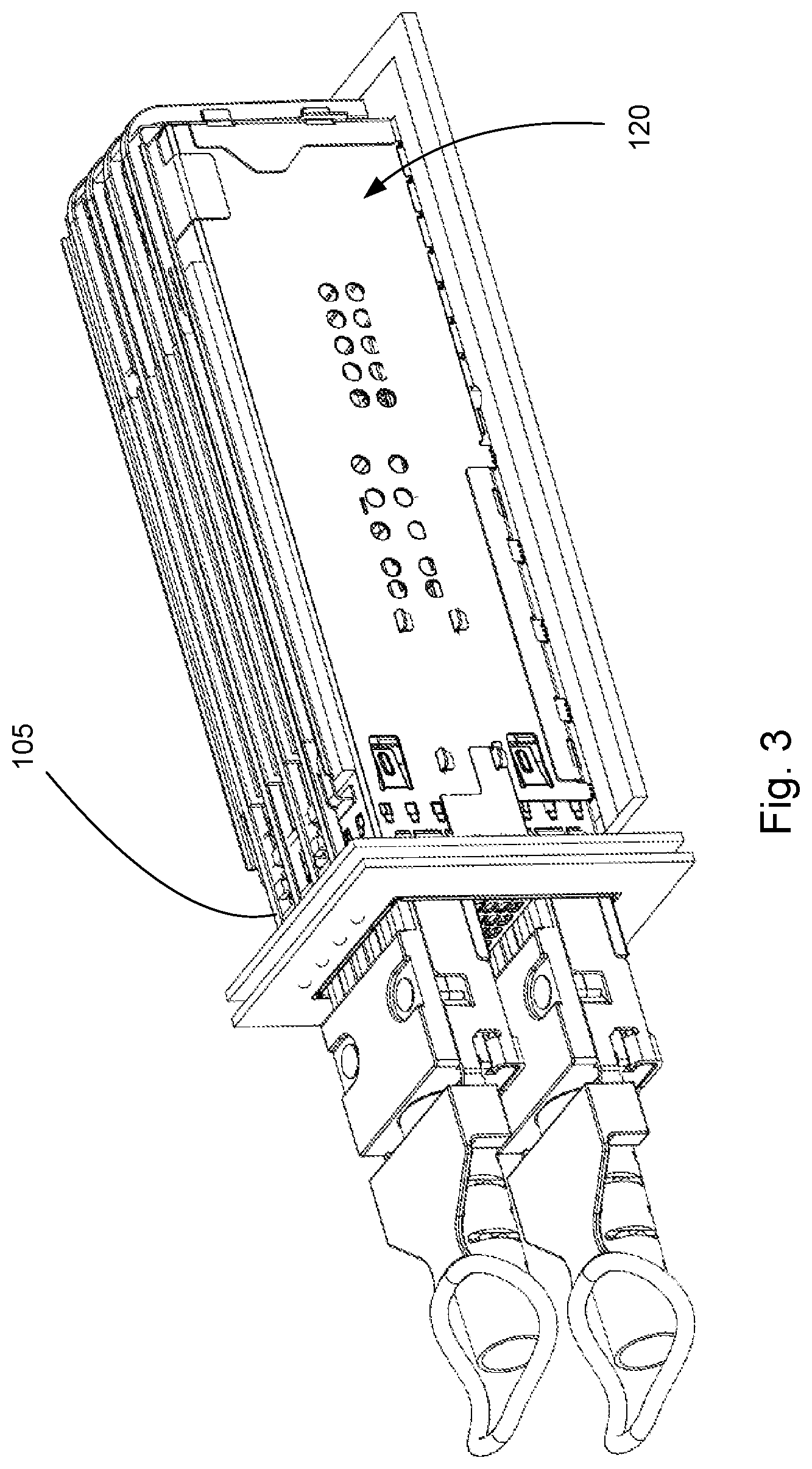
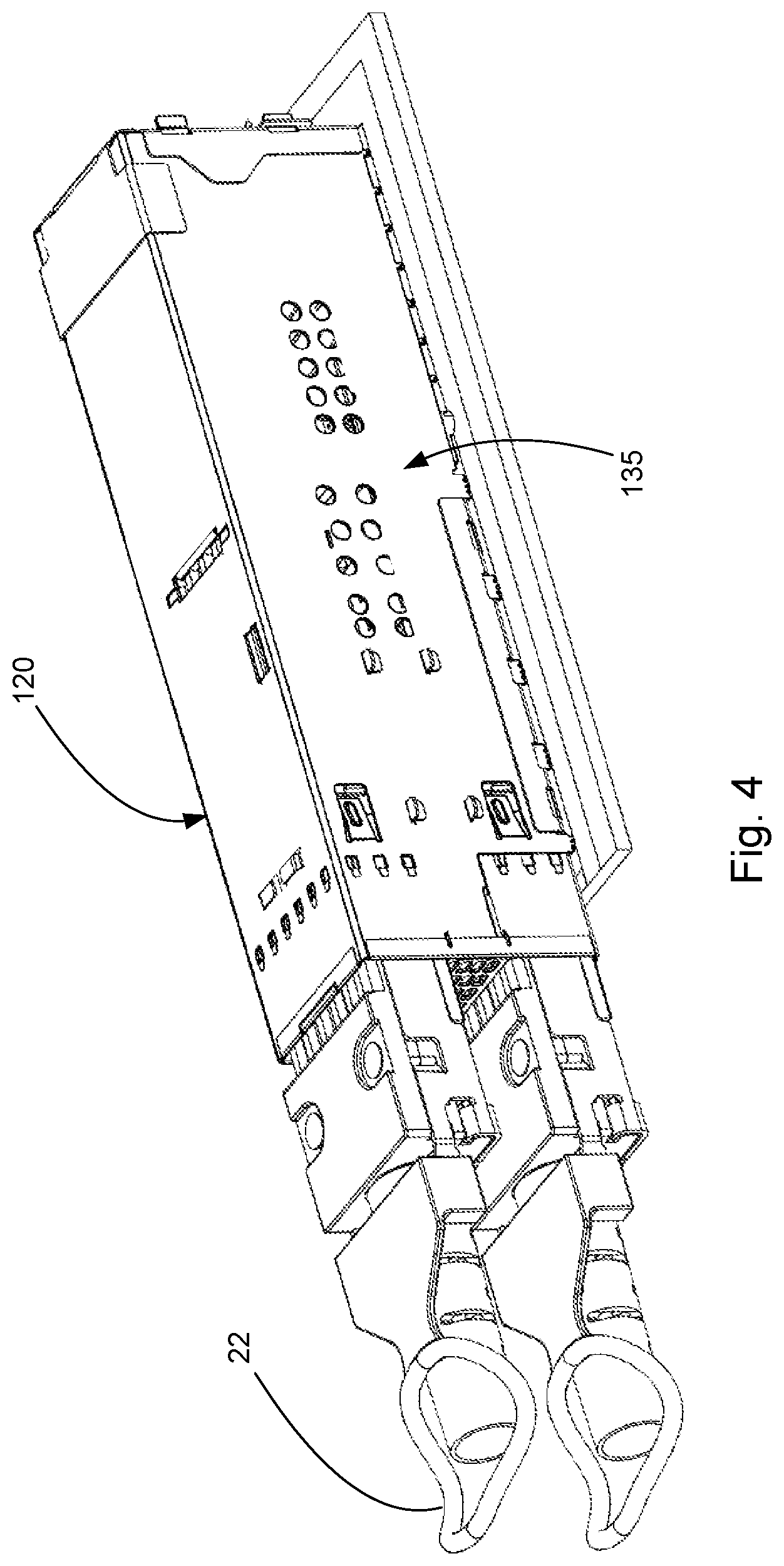
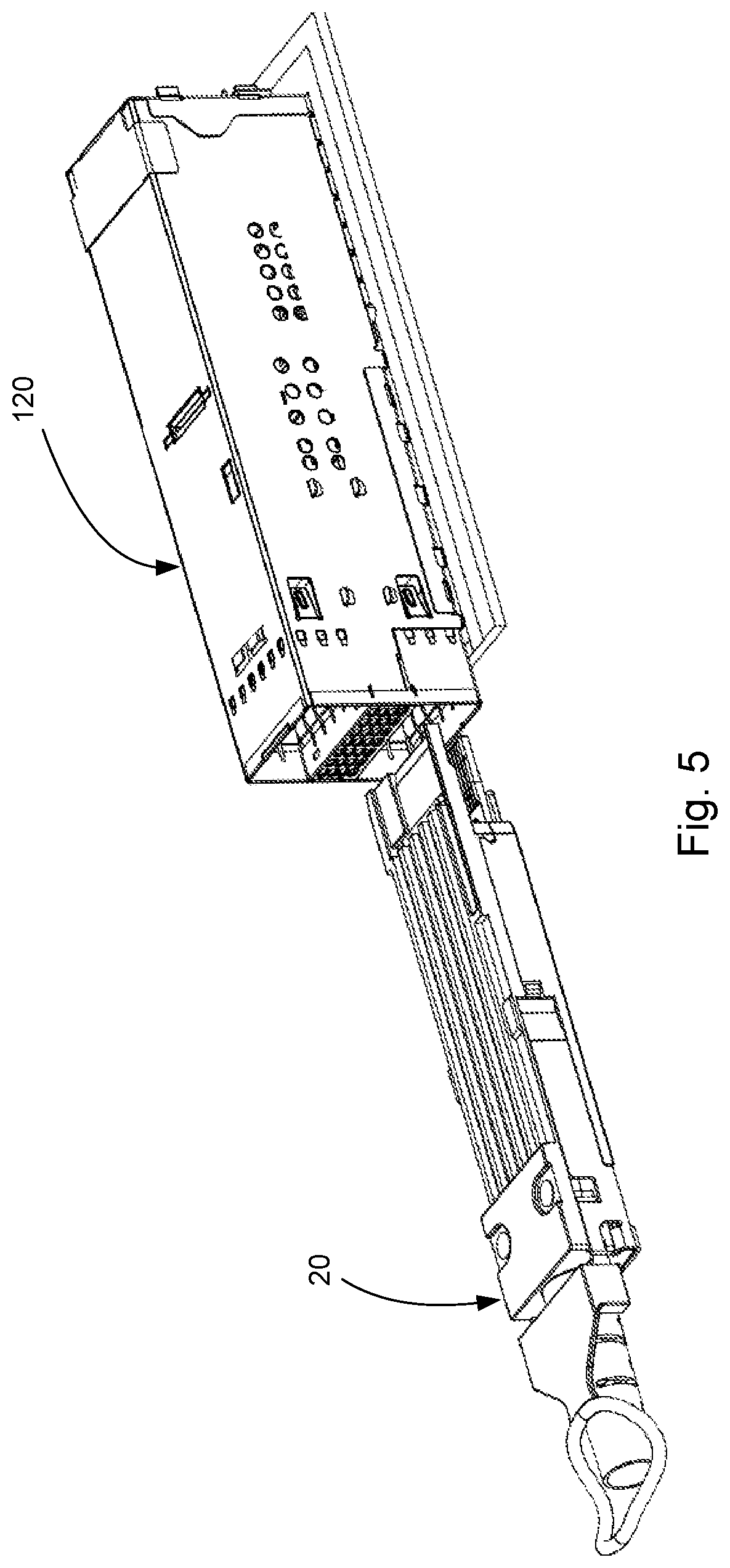
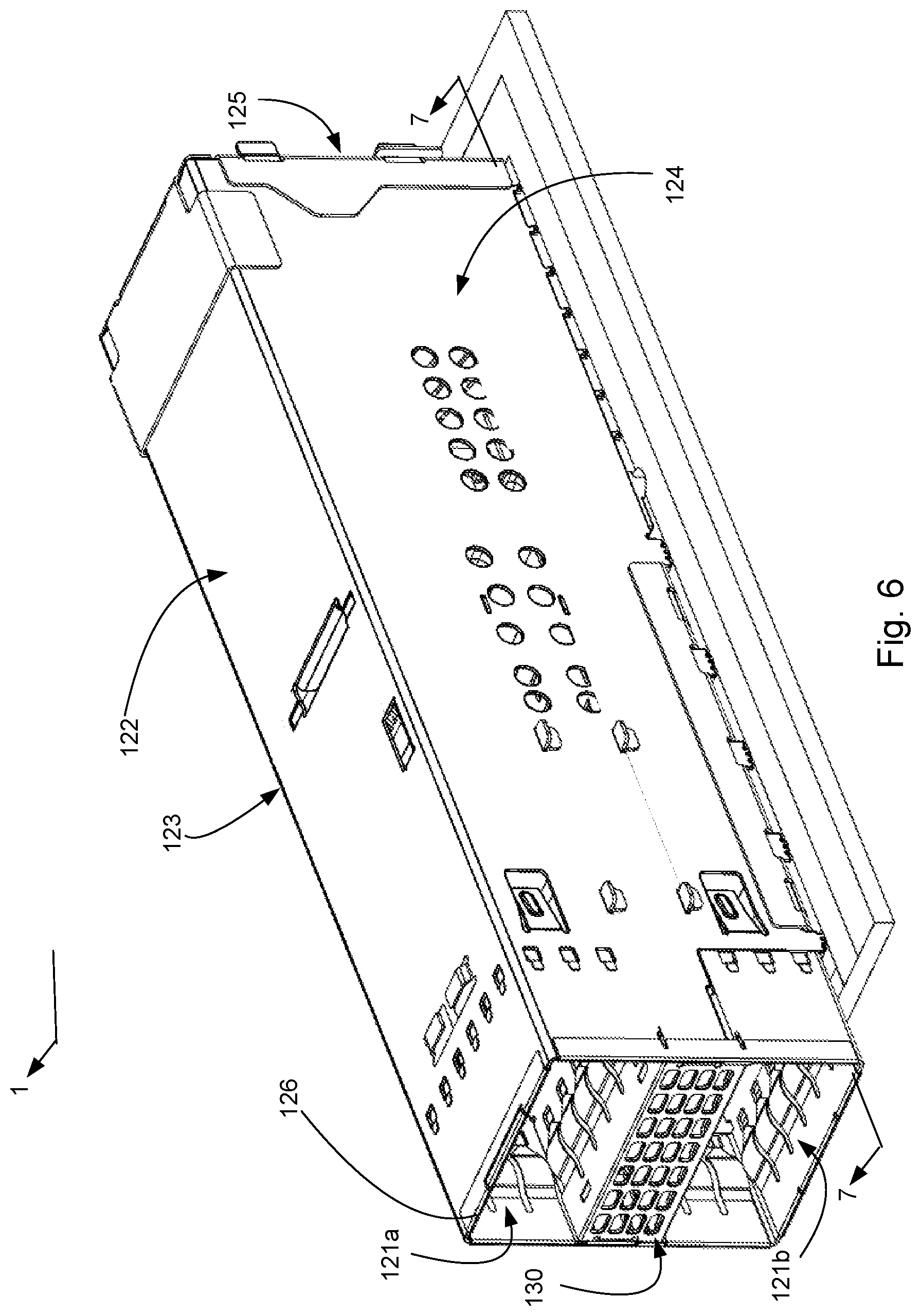
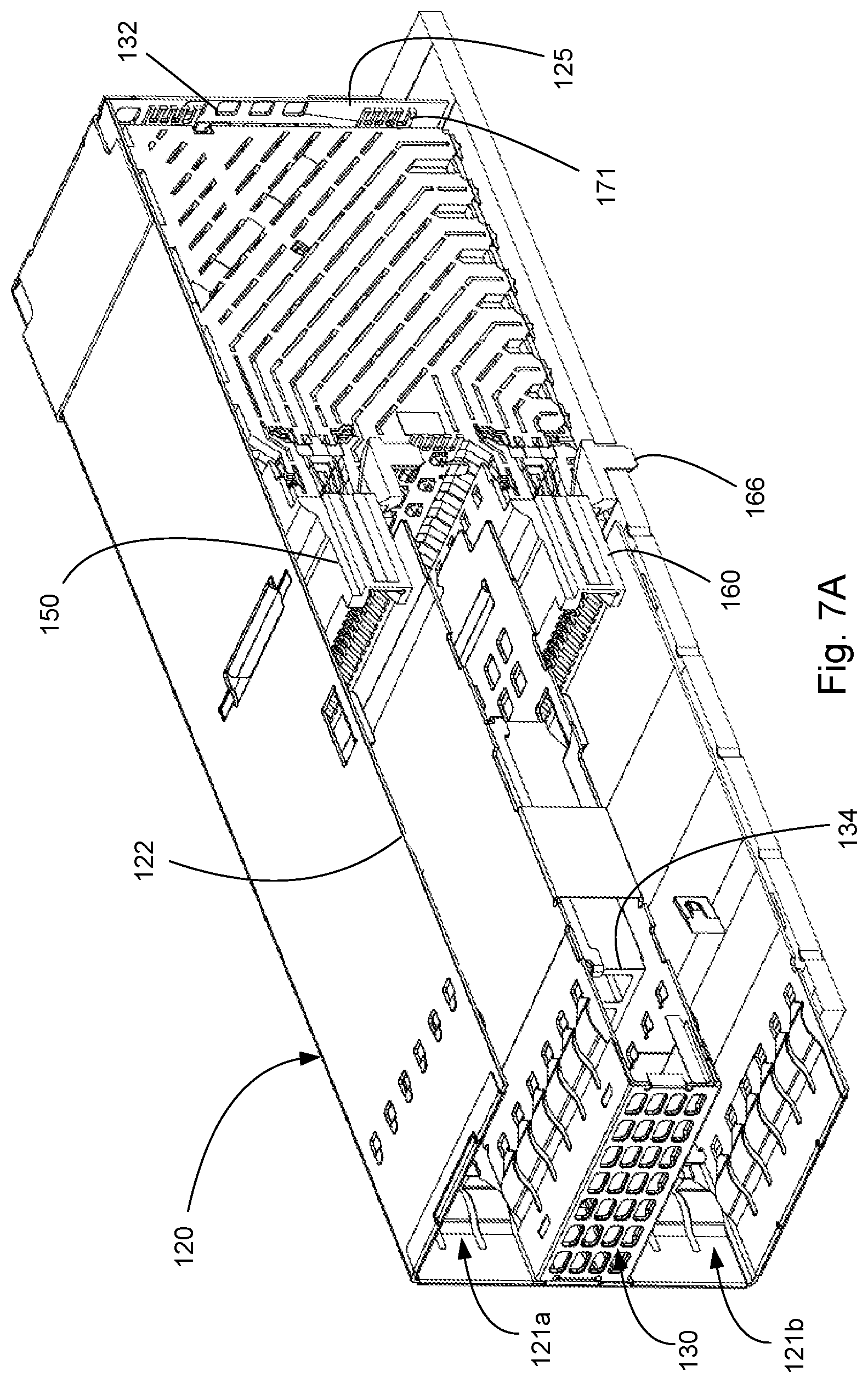
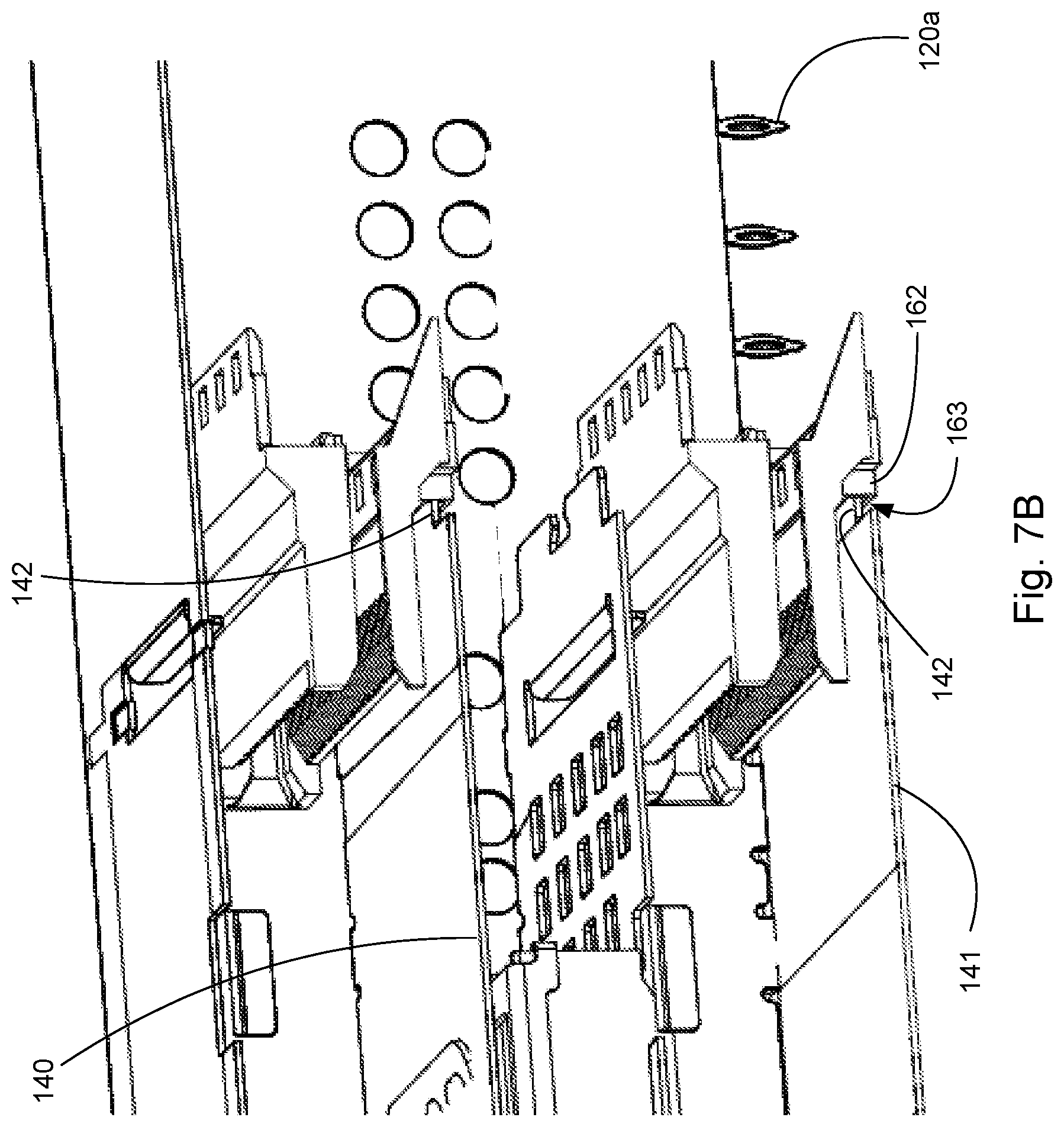
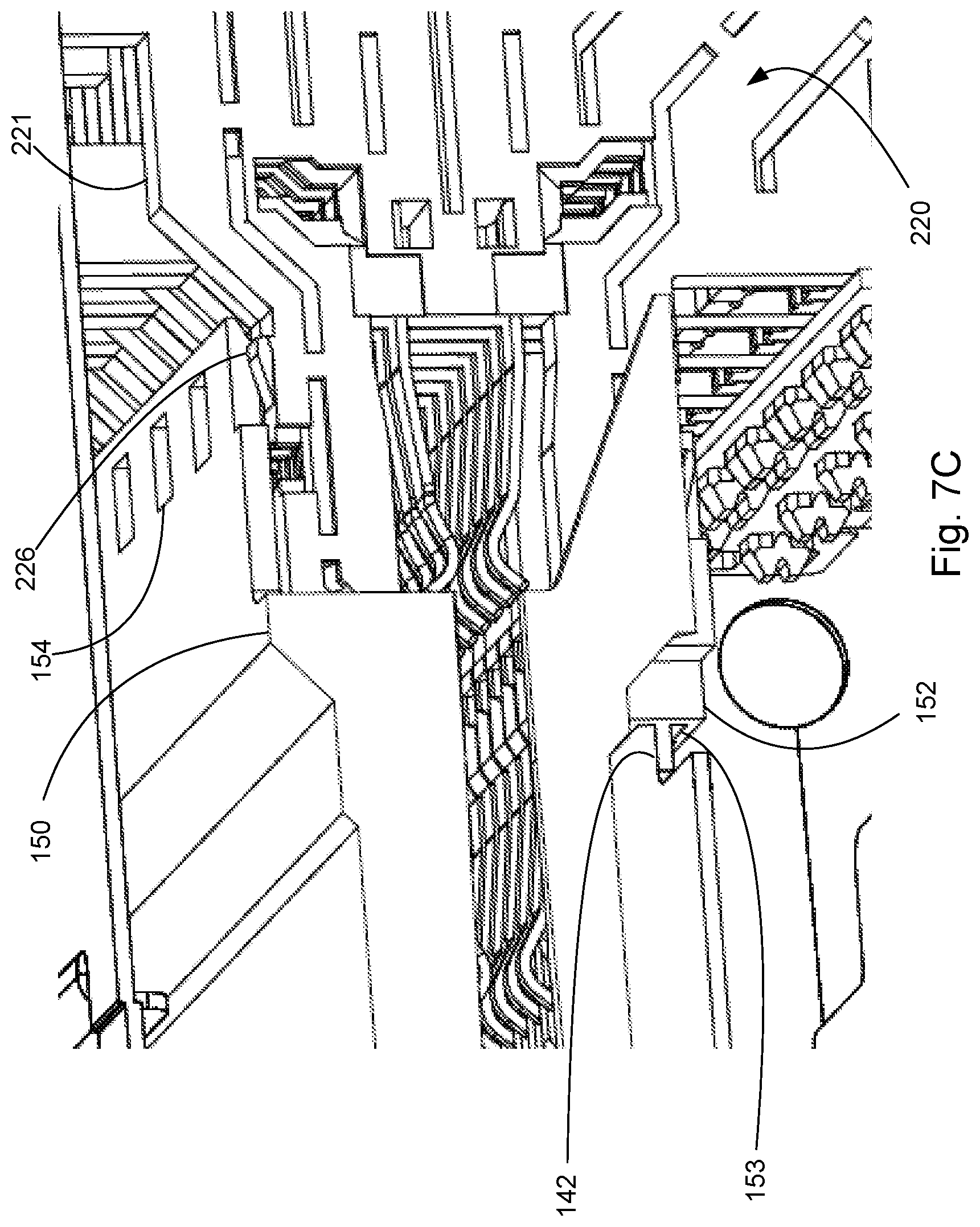
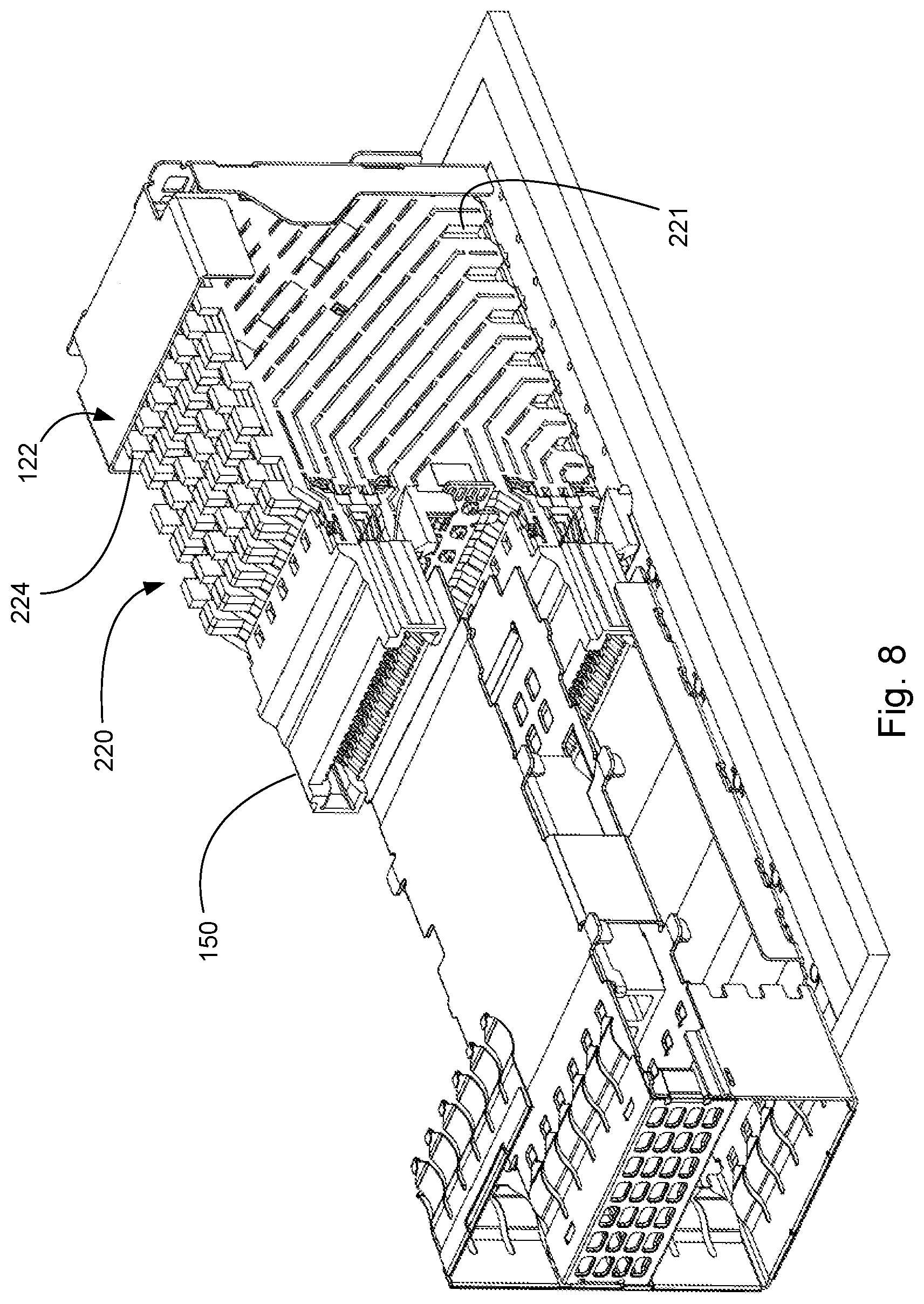
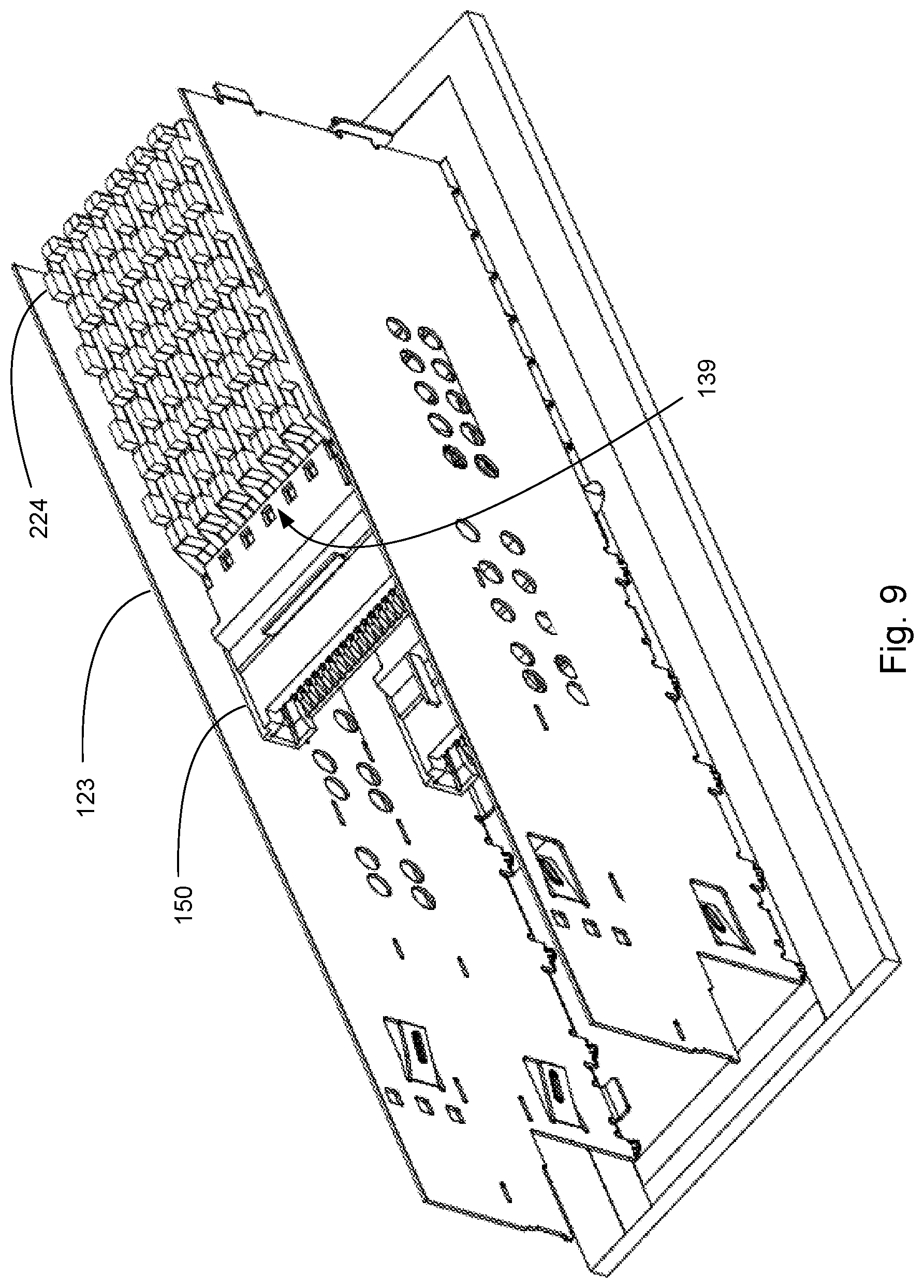
View All Diagrams
| United States Patent | 11,309,655 |
| Avery , et al. | April 19, 2022 |
High density receptacle
Abstract
A receptacle is depicted. The receptacle can provide two rows of terminals to increase the density of the interface. If desired, a connector positioned in the receptacle can omit the use of a housing, even if the receptacle provides a stacked connector configuration. With the use of various airflow features it is possible to cool inserted plug modules that use more than 6 watts and potentially more than 8 watts of power.
| Inventors: | Avery; Hazelton (Batavia, IL), Regnier; Kent E. (Lombard, IL) | ||||||||||
|---|---|---|---|---|---|---|---|---|---|---|---|
| Applicant: |
|
||||||||||
| Family ID: | 1000006245283 | ||||||||||
| Appl. No.: | 16/302,225 | ||||||||||
| Filed: | May 16, 2017 | ||||||||||
| PCT Filed: | May 16, 2017 | ||||||||||
| PCT No.: | PCT/US2017/032866 | ||||||||||
| 371(c)(1),(2),(4) Date: | November 16, 2018 | ||||||||||
| PCT Pub. No.: | WO2017/201024 | ||||||||||
| PCT Pub. Date: | November 23, 2017 |
Prior Publication Data
| Document Identifier | Publication Date | |
|---|---|---|
| US 20190305468 A1 | Oct 3, 2019 | |
Related U.S. Patent Documents
| Application Number | Filing Date | Patent Number | Issue Date | ||
|---|---|---|---|---|---|
| 62337064 | May 16, 2016 | ||||
| Current U.S. Class: | 1/1 |
| Current CPC Class: | H01R 13/6587 (20130101); H01R 13/6471 (20130101); H01R 12/721 (20130101); H01R 13/514 (20130101) |
| Current International Class: | H01R 13/514 (20060101); H01R 12/72 (20110101); H01R 13/6471 (20110101); H01R 13/6587 (20110101) |
References Cited [Referenced By]
U.S. Patent Documents
| 4298237 | November 1981 | Griffith et al. |
| 4548452 | October 1985 | Gillett |
| 4560221 | December 1985 | Olsson |
| 4598966 | July 1986 | Boland |
| 4806103 | February 1989 | Kniese et al. |
| 5051099 | September 1991 | Pickles et al. |
| 5110309 | May 1992 | Ichitsubo |
| 5239748 | August 1993 | Hamilton |
| 5425651 | June 1995 | Thrush et al. |
| 5986880 | November 1999 | Santeler et al. |
| 6074228 | June 2000 | Berg et al. |
| 6203328 | March 2001 | Ortega et al. |
| 6645009 | November 2003 | Billman et al. |
| 7128596 | October 2006 | Masaki et al. |
| 7204717 | April 2007 | Chang et al. |
| 7309239 | December 2007 | Shuey |
| 7453338 | November 2008 | Aronson |
| 7798820 | September 2010 | Hong |
| 7845975 | December 2010 | Cheng et al. |
| 7905729 | March 2011 | Goosens |
| 7963799 | June 2011 | Lee et al. |
| 8292669 | October 2012 | Wang et al. |
| 8353707 | January 2013 | Wang et al. |
| 8353728 | January 2013 | Wang et al. |
| 8506333 | August 2013 | Wang et al. |
| 8545240 | October 2013 | Casher |
| 8614398 | December 2013 | Regnier et al. |
| 8690608 | April 2014 | Naito et al. |
| 8696389 | April 2014 | Mason et al. |
| 8727793 | May 2014 | Cafiero et al. |
| 8845351 | September 2014 | Johnson |
| 8858237 | October 2014 | Hsu et al. |
| 8944830 | February 2015 | Little et al. |
| 9065225 | June 2015 | Degner et al. |
| 9136236 | September 2015 | Starkston et al. |
| 9484673 | November 2016 | Yang |
| 9525245 | December 2016 | Regnier et al. |
| 9711911 | July 2017 | Regnier et al. |
| 9748713 | August 2017 | Regnier et al. |
| 9806476 | October 2017 | Long |
| 2003/0203676 | October 2003 | Hasircoglu |
| 2004/0072467 | April 2004 | Jordan et al. |
| 2005/0009402 | January 2005 | Chien |
| 2005/0032429 | February 2005 | Hull et al. |
| 2007/0072457 | March 2007 | Hamazaki |
| 2011/0223805 | September 2011 | Regnier et al. |
| 2012/0156938 | June 2012 | Zhang |
| 2013/0115815 | May 2013 | Lim et al. |
| 2013/0189856 | July 2013 | Ko et al. |
| 2013/0196553 | August 2013 | Gailus |
| 2013/0344745 | December 2013 | Nichols |
| 2014/0071646 | March 2014 | Qian et al. |
| 2014/0227898 | August 2014 | Zhang |
| 102197540 | Sep 2011 | CN | |||
| 103858284 | Jun 2014 | CN | |||
| 105207012 | Dec 2015 | CN | |||
| 105390848 | Mar 2016 | CN | |||
| H05-242937 | Sep 1993 | JP | |||
| 2010-267503 | Nov 2010 | JP | |||
| 2011-029174 | Feb 2011 | JP | |||
| 201401667 | Jan 2014 | TW | |||
| 201515332 | Apr 2015 | TW | |||
| 201539868 | Oct 2015 | TW | |||
| WO 2008-012428 | Jan 2008 | WO | |||
| WO 2012-027679 | Mar 2012 | WO | |||
| WO2013/022889 | Feb 2013 | WO | |||
| WO2013/166380 | Nov 2013 | WO | |||
| 2015021221 | Feb 2015 | WO | |||
| 2015/148786 | Oct 2015 | WO | |||
| 2017/201024 | Nov 2017 | WO | |||
Other References
|
International Search Report and Written Opinion received for PCT Patent Application No. PCT/US2017/032866, dated Jul. 26, 2017, 11 pages. cited by applicant . International Preliminary Report on Patentability and Written Opinion received for PCT Patent Application No. PCT/US2017/032866, dated Nov. 29, 2018, 7 pages. cited by applicant . Notification of Reasons for refusal received for JP patent application No. 2018-560609, dated Jan. 7, 2020, 11 pages. (6 pages of English translation and 5 pages of official copy). cited by applicant . Office action received for JP application No. 2018-560609, dated Sep. 8, 2020, 8 pages. (4 pages of english translation and 4 pages of official copy). cited by applicant. |
Primary Examiner: Leon; Edwin A.
Parent Case Text
RELATED APPLICATIONS
This application is a national stage of International Application No. PCT/US2017/032866, filed May 16, 2017, which claims priority to U.S. Provisional Application No. 62/337,064, filed May 16, 2016, both of which are incorporated herein by reference in their entirety.
Claims
We claim:
1. A receptacle, comprising: a cage with a top wall, two side walls and a rear wall, the cage defining a port; a wafer set positioned in the cage, the wafer set including a plurality of wafers, the wafer set not being supported by a housing that extends along a substantial portion of the wafer set, the wafer set having a first side, a second side and a third side, each of the wafers in the wafer set having an insulative frame that supports a plurality of terminals, at least one terminal from the wafer set having a folded form, the folded form orienting a contact end of the at least one terminal to face the top wall, wherein at least some of the wafers in the wafer set are arranged in a ground, signal, signal pattern; two retaining bars, one of the retaining bars position on the first side and the other of the two retaining bars positioned on the second side.
2. The receptacle of claim 1, further comprising a third retaining bar that is positioned on the third side.
3. The receptacle of claim 1, wherein the first retaining bar extends from one of the side walls to the other side wall.
4. The receptacle of claim 3, wherein the first retaining bar extends out past the wafer set.
5. The receptacle of claim 1, further comprising a card slot member supported by the wafer set.
6. A receptacle, comprising: a cage with a top wall, two side walls and a rear wall, the cage defining a port; and a wafer set positioned in the cage, the wafer set including a plurality of wafers, the wafer set having a first side, a second side and a third side, each of the wafers in the wafer set having an insulative frame that supports a plurality of terminals, at least one terminal from the wafer set having a folded form, the folded form orienting a contact end of the at least one terminal to face the top wall, wherein at least some of the wafers in the wafer set are arranged in a ground, signal, signal pattern, wherein the plurality of wafers extend to the top wall.
7. The receptacle of claim 6, wherein the plurality of wafers have cutouts in the insulative frame adjacent the top wall so as to provide a tortuous air path along the top wall and through the cutouts.
8. A connector assembly, comprising: a cage that defines a port, the cage having a top wall, the cage configured to be mounted on a supporting surface; a card slot member positioned in the port; a wafer set aligned with the card slot, the wafer set including a plurality of wafers that each support at least four terminals, wherein the terminals are arranged so that two rows of contacts are provided on a first side and a second side of the card slot, at least one terminal from the wafer set having a folded form, the folded form orienting a contact end of the at least one terminal to face the top wall, wherein the card slot member is configured to be suspended from the supporting surface and is only supported by the wafer set and the cage.
9. The connector assembly of claim 8, wherein the two rows of contacts on the first side are opposite the two rows of contacts on the second side and form a front top row of contacts, a rear top row of contacts, a front bottom row of contacts and a rear bottom row of contacts, wherein the rear top row of contacts and the rear bottom row of contacts have pad touching portions that are offset from each other.
10. The connector assembly of claim 8, wherein the two rows of contacts on the first side are opposite the two rows of contacts on the second side and from a front top row of contacts, a rear top row of contacts, a front bottom row of contacts and a rear bottom row of contacts, wherein the terminals that form the rear top row and rear bottom row of contacts have tails that are aligned between tails of the terminals that form the front top row and front bottom row of contacts.
11. The connector assembly of claim 8, further comprising an additional terminal from the wafer set having a folded form, the folded from orienting a contact end of the additional terminal to face the contact end of one of the at least one terminal.
12. The receptacle of claim 1, further comprising an additional terminal from the wafer set having a folded form, the folded form orienting a contact end of the additional terminal to face the contact end of one of the at least one terminal.
Description
TECHNICAL FIELD
This disclosure relates to the field of input/output (IO) connectors, more specifically to IO connectors suitable for use in high data rate applications.
DESCRIPTION OF RELATED ART
Input/output (IO) connectors are designed to support high data rates and a number of improvements have been developed to help provide data rates that reach 25 Gbps and even higher. In order to support consumer needs and desires, however, many companies are looking at ways to support higher data rates. As a result, development work into supporting 50 Gbps using NRZ encoding and 100 Gbps using PAM 4 encoding are underway. These increases will pose significant problems for existing manufacturing techniques, however, as conventional circuit boards cannot readily support 25 GHz signals. Thus new architectures and methods will be required.
Another method to support increased data rates has been to try to increase the number of ports. One way to increase the number of ports is to shrink the size of the connector. For example, it is common for many standard connectors to be designed to work on a 0.8 mm or 0.75 mm pitch and recently a connector standard that support 0.5 mm has been approved (the OCULINK connector). While shrinking the connector size works well for clean sheet designs and is effect at supporting very high density at the front of rack, smaller connectors are more challenging to use for optical connector designs as the very small size makes it challenging to dissipate sufficient thermal energy. They also tend to use smaller sized conductors, which makes it difficult to support more than 2 or 3 meter length cables. In addition, for people that wish to have some level of backward compatibility, the new smaller connector size poses potential issues. As a result, certain individuals would appreciate further improvements in connector technology.
SUMMARY
A connector is disclosed that includes a set of wafers formed of terminals supported by an insulative frame. The set of wafers can be positioned in a cage without a housing. Card slots members are aligned with contacts of the terminals. In an embodiment a connector can include a wafer that supports two rows of terminals on both sides of a card slot and the connector can be arranged to have a press-fit tails.
BRIEF DESCRIPTION OF THE DRAWINGS
The present invention is illustrated by way of example and not limited in the accompanying figures in which like reference numerals indicate similar elements and in which:
FIG. 1 illustrates a perspective view of an embodiment of connector system.
FIG. 2 illustrates a perspective sectional view of the embodiment depicted in FIG. 1, taken along line 1-1.
FIG. 3 illustrates another perspective view of the embodiment depicted in FIG. 1.
FIG. 4 illustrates a simplified perspective view of the embodiment depicted in FIG. 3.
FIG. 5 illustrates a perspective view of an embodiment of a plug module prior to insertion into a receptacle.
FIG. 6 illustrates a perspective view of an embodiment of a receptacle.
FIG. 7A illustrates a perspective sectional view of the embodiment depicted in FIG. 6, taken along line 7-7.
FIG. 7B illustrates an enlarged simplified perspective view of the embodiment depicted in FIG. 7A.
FIG. 7C illustrates a enlarged perspective view of an embodiment depicted in FIG. 7A.
FIG. 8 illustrates a perspective view of the embodiment depicted in FIG. 6 with the cage partially removed.
FIG. 9 illustrates a simplified perspective view of the embodiment depicted in FIG. 6 with the top wall and front portion of the cage removed.
FIG. 10 illustrates a perspective cross-sectional view of the embodiment depicted in FIG. 7 with a modified top wall.
FIG. 11A illustrates a perspective view of an embodiment of a connector.
FIG. 11B illustrates an enlarged perspective view of the embodiment depicted in FIG. 11A.
FIG. 12 illustrates another perspective view of the embodiment depicted in FIG. 11A.
FIG. 13 illustrates a partially exploded perspective view of the embodiment depicted in FIG. 11A.
FIG. 14 illustrates an enlarged perspective view of the embodiment depicted in FIG. 13.
FIG. 15 illustrates a perspective view of the embodiment depicted in FIG. 13 with the card slot plug removed.
FIG. 16 illustrates a perspective view of an embodiment of a retaining bar securing a wafer set.
FIG. 17 illustrates an exploded partial perspective view of an embodiment of a connector.
FIG. 18 illustrates a partially exploded perspective view of an embodiment of a signal wafer pair surrounded by ground wafers.
FIG. 19 illustrates a simplified perspective view of the embodiment depicted in FIG. 18 with an insulative frame removed for illustrative purposes.
FIG. 20 illustrates a perspective view of an embodiment of a signal wafer pair.
FIG. 21 illustrates a perspective view of the embodiment with the insulative frame removed.
FIG. 22 illustrates a perspective view of an embodiment of terminals that provide the contact rows in the bottom port.
FIG. 23 illustrates another perspective view of the embodiment depicted in FIG. 22.
FIG. 24 illustrates an elevated side view of the embodiment depicted in FIG. 22.
FIG. 25A illustrates a plan view of the embodiment depicted in FIG. 21.
FIG. 25B illustrates an enlarged plan view of the embodiment depicted in FIG. 25A.
FIG. 26 illustrates a schematic depiction of an embodiment of a connector with an insert.
DETAILED DESCRIPTION
The detailed description that follows describes exemplary embodiments and is not intended to be limited to the expressly disclosed combination(s). Therefore, unless otherwise noted, features disclosed herein may be combined together to form additional combinations that were not otherwise shown for purposes of brevity.
As can be appreciated from FIGS. 1-5, a receptacle 100 is mounted on a circuit board and provides a right-angled construction that is configured to receive plug module 20. The depicted receptacle 100 design is beneficial to use with plug modules that include cooling slots 115. While the use of cooling slots 115 in a module is not required the cooling slots 115 can provide additional cooling and make it easier, when used with other features disclosed herein, to cool a module that uses 8 or more watts of power.
The receptacle 100 includes a cage 120 and can support light pipes 105 if desired. The cage includes a top wall 122, a first side wall 123, a second side wall 124, a rear wall 124 and a front edge 126. The receptacle 100 defines a top port 121a and a bottom port 121b. The first and second side walls 123, 124 can include vent apertures 135.
As can be appreciated, the depicted designs are intended to facilitate cooling of an inserted plug module 20. Thus, the design has been tailored to improve air flow in a number of ways that will be discussed herein. In certain embodiments the receptacle 100 can include an internal riding heat sink 134 that is in communication with a front grill 130 and a rear aperture set 132. The top wall 122 can include a cooling aperture 122a and an external riding heat sink 133 can be positioned therein. Riding heat sinks are typically designed so that the extend into the port and engage an inserted plug module, helping to provide a conductive path to direct heat away from the plug module. It should be noted that in certain circumstances it may not be desirable to have the additional cooling (for example, in applications where there is no intention to use active modules) and in such situations many of the optional thermal features can be omitted. Thus, the depicted internal riding heat sink and the various venting features can be omitted if not desired.
One common design of existing receptacles is the use of a housing positioned inside of a cage, the housing helping to define a connector. The cage helps support the mating plug module, can help support the connector and can also provide EMI protection. The connector positioned in the cage supports terminals that include tails and contacts that allow the mating plug module to be electrically connected to a circuit board (or to cables if a Bipass design is desired). The receptacle, which is typically press-fit onto a circuit board to ease assembly, thus must have the terminals of the connector aligned with terminals on the cage. As can be appreciated, the cage can be formed of metal and is expected to have a fairly repeatable arrangement of tails that have the desired dimensional control with respect to each other. The tails of the connector can also be carefully manufactured so that they are aligned with each other. It is somewhat more difficult, however, to align the tails of the connector with the tails of the cage as there are multiple points of dimensional stack-up. This dimensional issues is made more difficult by the fact that in a typical press fit design the housing supports wafers that support the terminals. Thus, the terminals are dimensional controlled with respect to each other within a wafer but have dimensional stack-up with respect to both the housing and other wafers while the housing has dimensional stack-up with the cage. Prior designs attempted to have a datum that acts as a stop to carefully control insertion of the housing into the cage to control the tolerances between the datum point and the tails of both the cage and the connector.
While such control is possible, it turns out to be more challenging and difficult, particularly as the tails are reduced in size. Applicants have determined that instead of having a stop that limits and controls the position of the housing with respect to the cage it is more desirable to have a system where the cage 120 and connector 129 are mated together in a manner that allows for infinite adjustment over a small range so that mating of the cage 120 and the connector 129 can be done in a controlled manner and dimensional control can be assured. As depicted, the cage 120 includes bottom walls 140, 141 that each have a tongue 142 that is inserted into the respective card slot plug 150, 160. More specifically, the tongues 142 from the cage 120 are inserted into tongue slots 153, 163 in mating portions 152, 162, respectively, of card slot plugs 150, 160. As can be appreciated, the card slot plugs 150, 160 engage a wafer set 220 and would provide some additional dimensional stack up therebetween. In an embodiment, the insertion can be done based on alignment between the wafer set 220 and the cage 120, thus eliminating some of the dimensional stack up that would otherwise exist. In an embodiment the tongues 142 have an interference fit with the tongue slots 153, 163 so that the cage and connector 129 are appropriately joined and stay at the appropriate location relative to each other. Such a manufacturing process allows a position of the cage 120 and the wafer set 220 to be better controlled with respect to each other and improves the yield of receptacles 100 while ensuring the receptacle 100 can properly be mounted on a circuit board.
As can be appreciated from the Figures, the depicted connector 129 omits a housing. Applicants have surprisingly discovered that the use of a housing is unnecessary to support a wafer set 220 so long as the wafers are securely fastened together, preferably on at least two sides. In a depicted embodiment retaining bars 171 are positioned on opposing sides and one of the sides has two retaining bars 171. The retaining bars 171 are connected to wafers 221 via wafer nubs 229 that can be heat staked onto the retaining bars 171. The depicted connector 129 illustrates an embodiment where a triangular arrangement is provided with two retaining bars 171 positioned on one side and one retaining bar 171 positioned on a second side of the wafer set. While it is desirable to have at least two retaining bars 171 (each positioned on a different side of the connector) a triangular arrangement of retaining bars 171 has been determined to be beneficial as it provides improved control and support for wafers 221 that make up the wafer set 220. It has been determined that removing the housing provides certain unexpected benefits. One issue is that no housing is perfectly square and straight, thus the tolerance in the housing adds to the tolerance in the wafers and thus increases the tolerance of the location of the tails. By removing the housing Applicants can better control the position of the tails of the wafer set with respect to the cage. The removal of the housing also allows for the size of the receptacle to be decreased, thus allowing for increased density.
Each wafer 221 includes an insulative frame 221a. The depicted insulative frames 221a includes top projections 224 and supports terminal sets 252, 262, 272 (as is expected in embodiments where there is a three wafer system that includes a ground wafer and two signal wafers). It should be noted that the configuration of the depicted terminals, while beneficial for the depicted receptacle, is not intended to be limiting as the features of providing a connector without a housing has broad applicability. Thus the design elements that provide for the removal of the housing could be used with a wide range of wafer configurations.
The terminal set 252 includes terminals 253 that each include a contact 253a, a tail 253b and a body 253c that extends therebetween. Similarly, the terminal set 262 includes terminals 263 that include a contact 263a, a tail 263b and a body 263c that extends therebetween. As the depicted tails 253b, 263b are intended to press-fit into a circuit board it is helpful to provide a receptacle where force can be readily applied to the tails to press them into vias on a circuit board. As depicted, the insulative frame 121a includes top projections that extend to a top wall 122 of the cage 120. As a result of the depicted design, a force exerted on the cage 120 is transferred through the insulative frame 121a to the tails 253b, 263b and thus a reliable press-fit operation is possible.
The depicted top projections 124 have a number of cutouts 124a so that the wafer engages the top wall in several places but also leaves gaps. The cutouts 124a can be arranged in a pattern that allows air to flow along the top wall 122 of the cage in a desirable manner. As can be appreciated, the number and size of the cutouts 124a, as well as the location, can vary as appropriate to provide the desired air flow.
It should be noted that the cutouts 124a, while providing a tortuous path for air to flow through, do not provide a straight path for the air to flow between the wafers and the top wall and thus may increase the pressure drop of air flow through the receptacle. While the depicted path could be considered a zig-zag or undulating path, other paths could also be provided, depending on the configuration of the top wall. In an alternative embodiment the projection 124 can be shortened and an insert 129a (shown in schematic representation in FIG. 26) can positioned between the wafer set 220 and the top wall 122. The insert 129a can transfer force from the top wall 122 to the wafers 221 while providing a more optimized air flow path between the top wall 122 and the wafer set 220 (thus reducing air resistance). In another alternative embodiment the insert 129a can be removeable and just used to mount the connector on the circuit board 10 before being removed. In such a design the back wall 125 of the cage 120 can be attached after the cage 120 (or at least most of it) and connector 129 are both pressed into the circuit board and the opening can provide reduced air resistance. Thus a number of variations are possible, depending on the need for air flow and the desire to manage costs.
The depicted design provides wafers 221 that have a front contact row 245 and a rear contact row 246 that are spaced apart in a plug module insertion direction and the contact rows are configured to engage two rows of pads on a mating connector. While not required, the benefit of such a design is a substantial increase in density. If such density is not desired then the wafers can be made to support a lesser number of terminals. It should be noted that depicted wafers are arranged in pattern that provides a ground, signal, signal pattern that can be repeated. Other patterns are also possible if desired. If desired, the ground wafers could include terminals that are commoned together and in an embodiment the ground wafers could have contacts that engage the top wall to provide electrical grounding to the cage.
Because the connector 129 does not need a housing (although it is possible to use a housing if desired in certain embodiments), the depicted connector 129 supports card slots plugs with the wafer set 220. As depicted, the card slots plugs 150, 160 each have shoulders that are similar to the shoulders 156a, 156b that latch onto retaining features on at least some of the wafers in the wafer set 220 to provide desirable location and stability control. In an embodiment just the ground wafers can include retention features. As depicted, the shoulders 156a, 156b can have grooves 154 that engage projections 226 but other retention configurations would also be suitable. The card slot plugs 150, 160 are positioned in ports 121a, 121b defined by the cage 120 and provide card slots 151 that have contacts positioned on both sides of the card slots 151. The card slots 151 preferably include terminal grooves 155 for the front contact row 245 so that the most vulnerable contacts are protected during the initial mating with a mating plug connector. As the front portion of the card slot plugs 150, 160 helps align and control the mating paddle card, the rear contact row 246 can beneficially omit the terminal slots. If desired a card slot plug 160 can include a peg 166 that is intended to be inserted into a circuit board but such a feature is optional and is not expected to be as helpful for a design that includes two vertically arranged ports in a 2.times.N configuration.
In an embodiment the retaining bar 171 can be configured to engage the cage 120. The retaining bar 171 can be made wider than the wafer set 220 so that the retaining bar 171 slides along the side walls of the cage 220. If such a construction (which helps ensure proper alignment of the cage 120 to the wafer set 220) is desired then the retaining bar 171 can include vent apertures 172 to allow air to flow more readily through the receptacle.
It has been determined that for a full double row design it is desirable that the contacts all be blanked and formed (it has been determined that this provides mechanical and signal integrity benefits). Thus the depicted embodiment features two rows of stamped and formed contacts on both sides 151a, 151b of the card slot 151.
To support the front contact row 245, the wafers 221 include an arm 228 that extends past the rear contact row 246. The arm 228 helps ensure the impedance is more consistently managed through the body of the wafer. To provide for suitable flexibility the arm 228 can include a notch 228a that allows that arm 228 to flex slightly.
As noted above, each of the terminals includes the contact, tail and body extending therebetween. The depicted configuration includes a ground wafer 271 and a signal wafer set 250 that includes a first signal wafer 251 and a second signal wafer 261. The signal wafer set 250 thus provides for the top port a first different pair 254a, a second differential pair 254b, a third differential pair 254c and a fourth differential pair 254d. The signal wafer set 250 also provides for the bottom port a fifth differential pair 255a, a sixth differential pair 255b, a seventh differential pair 255c and an eighth differential pair 255d. From the depicted terminal configuration it can be appreciated that for both the top and bottom ports the terminals that form the two back differential pairs have tails that are positioned between tails of the two differential pairs that form the front contacts. For example, differential tail sets 257b and 257c are associated with contact pairs 258b and 258c, respectively and the contact pairs 258b, 258c are in the rear contact row. Differential tail sets 257a and 257d are on both sides of the differential tail sets 257b, 257c and are associated with contact pairs 258a, 258d that are in the front contact row. It has been determined that this configuration is beneficial as it allows for the three rows of terminals to have similar lengths while having one significantly longer terminal. Thus the depicted embodiment helps provide more consistent terminal lengths.
As can be appreciated, a top row of contacts opposes a bottom row of contacts. In an embodiment the contacts of the terminals that form that the top row of contact can have a form 256b that is folded in a first direction and the terminals that form the bottom row of contacts can have a form 256a that is also folded in the first direction. For example, when looking straight at the contacts in a plug module insertion direction all the sets of contacts can have forms that are folded to one side (e.g., they can all be folded to the left or to the right). While such a construction is beneficial, it turns out that for certain applications it is desirable to have the top row of contacts offset from the bottom row of contacts. To provide this functionality the contact can taper down from a beam portion 302a, 302b to a pad touching portion 301a, 301b, where the pad touching portion 301a, 301b is less than half the width of the beam portion 302a, 302b. If desired, the pad touching portion of the top row can be on opposite sides of the beam portion as the pad touching portions on the bottom row so as to provide an offset alignment. If such an alignment is not needed then the contacts can be configured symmetrically or in some other desired configuration.
The pitch can vary depending on the intended interface. As depicted the terminals are on a x pitch, which could be 0.8 mm and the top and bottom terminals can have a y offset, which can be 0.4 mm. If the connector provides a double row of contacts on the top and bottom and the front contacts are intended to be compatible with existing designs then it will be beneficial to have the pitch of the contacts match existing designs. If a clean sheet design is preferred then the pitch can be varied as desired, keeping in mind that signal integrity performance can be more challenging as the pitch decreases below 0.8 mm and that a pitch below 0.65 typically requires additional features such as biased paddle cards and/or contact interface (such as is used in the OCULINK connector).
The disclosure provided herein describes features in terms of preferred and exemplary embodiments thereof. Numerous other embodiments, modifications and variations within the scope and spirit of the appended claims will occur to persons of ordinary skill in the art from a review of this disclosure.
* * * * *
D00000

D00001

D00002

D00003

D00004

D00005

D00006

D00007

D00008

D00009

D00010

D00011

D00012
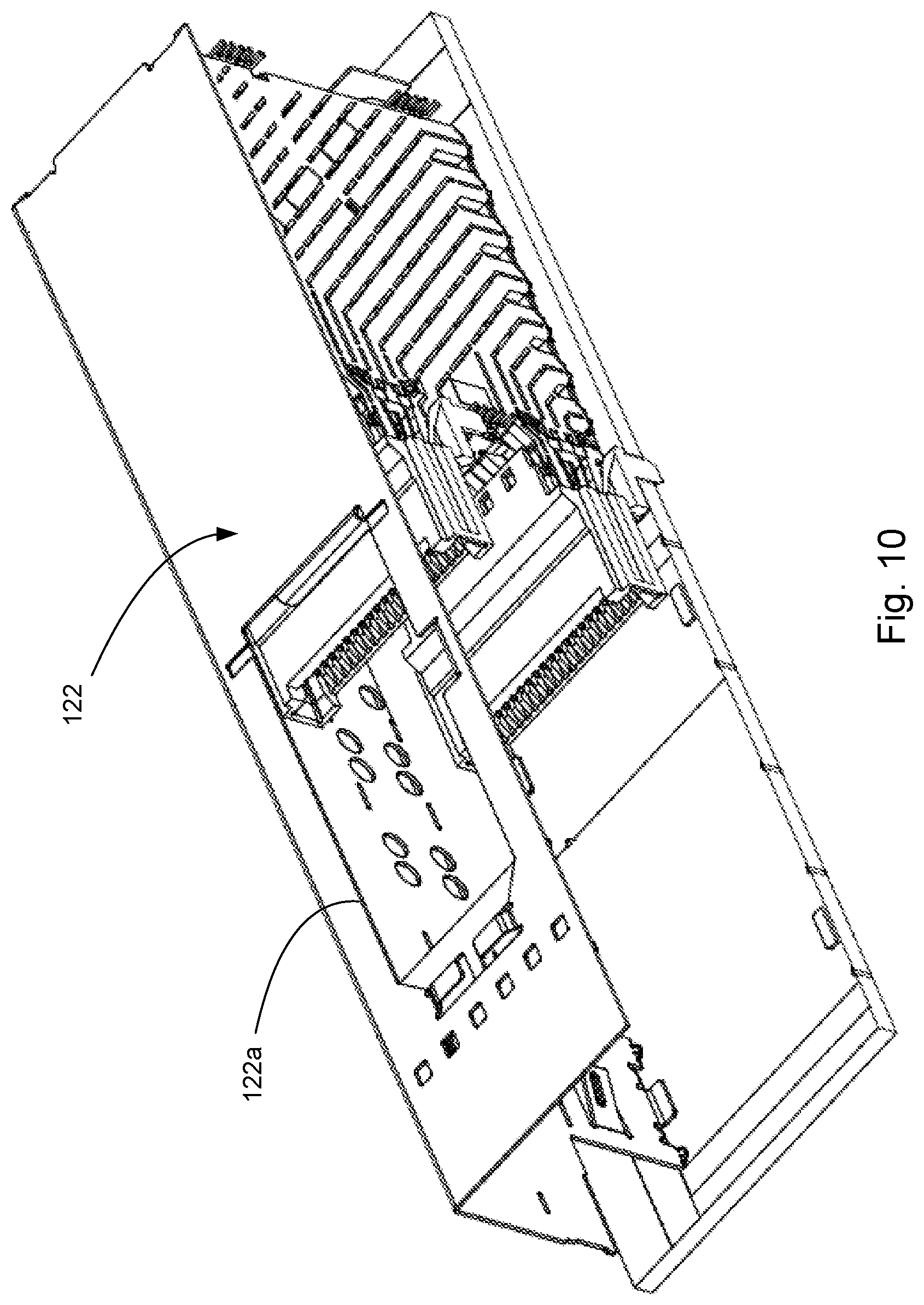
D00013
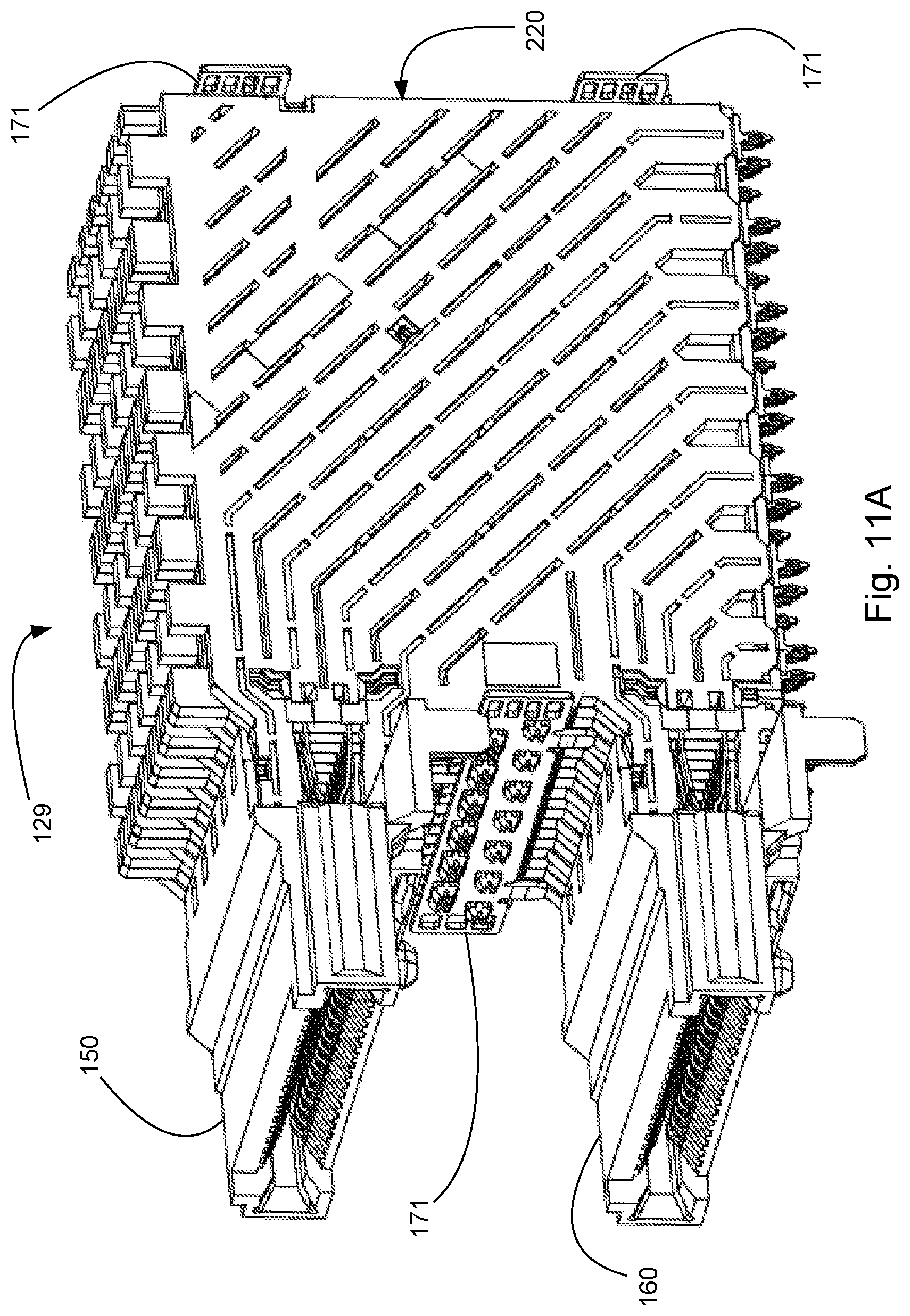
D00014
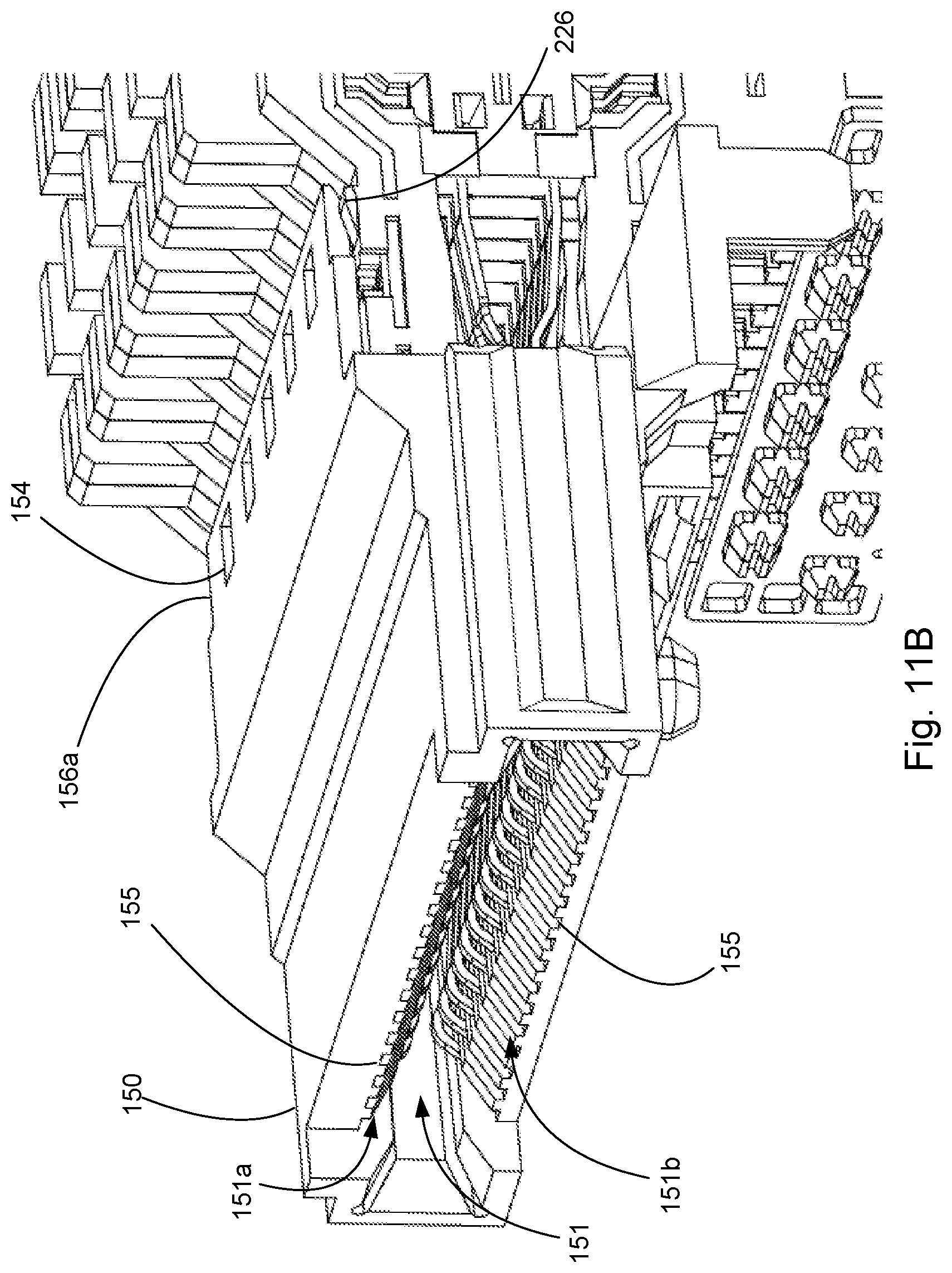
D00015
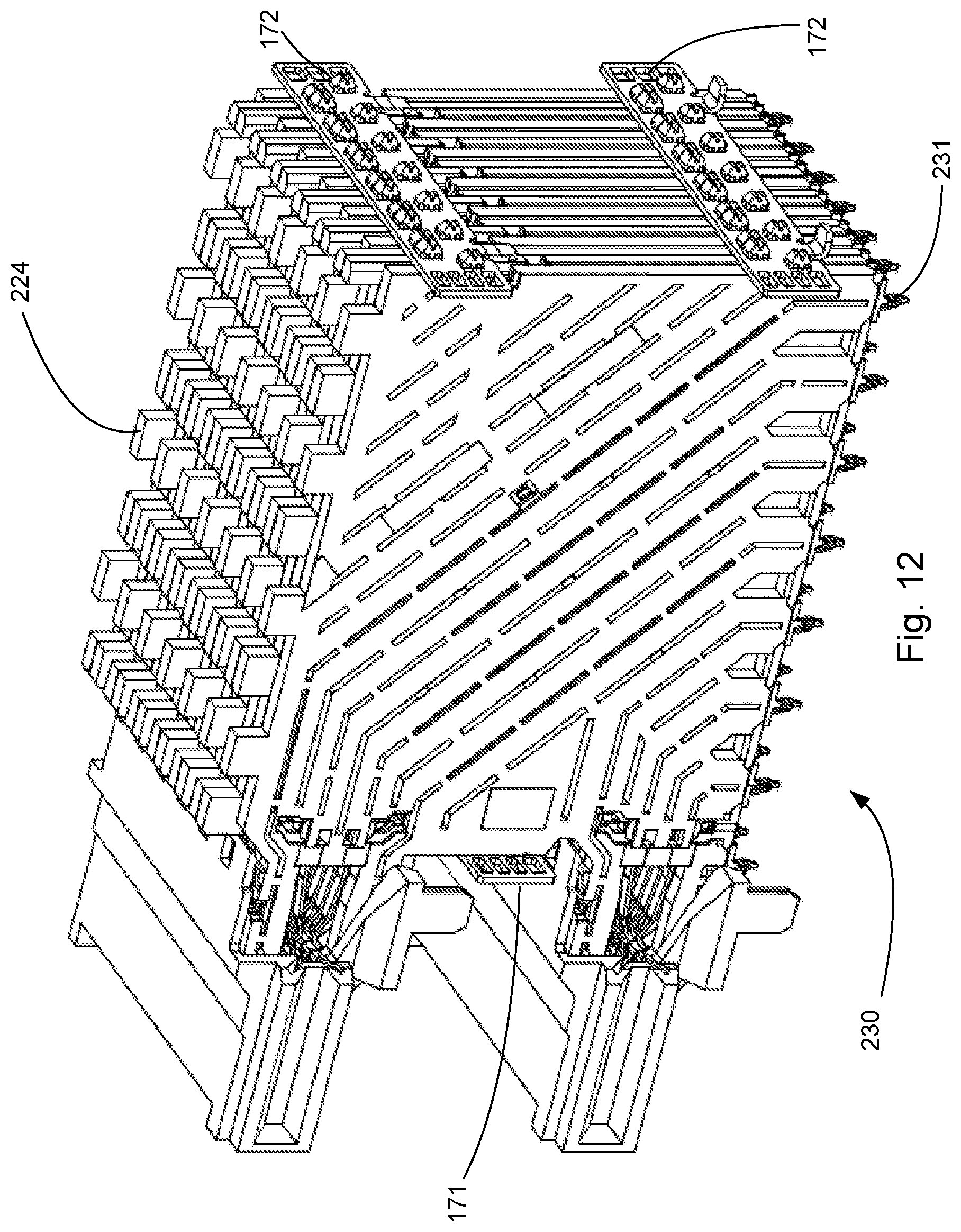
D00016
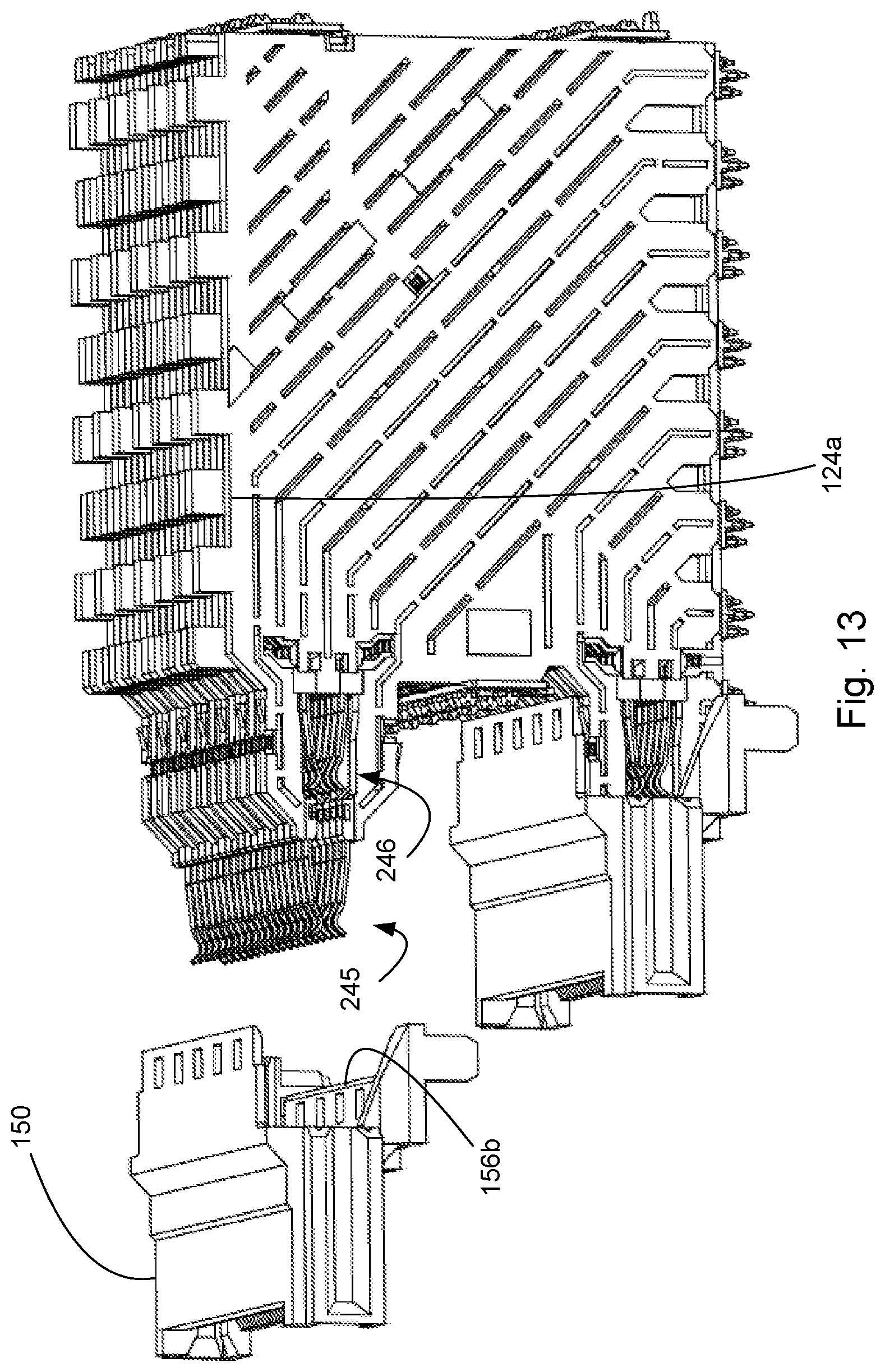
D00017
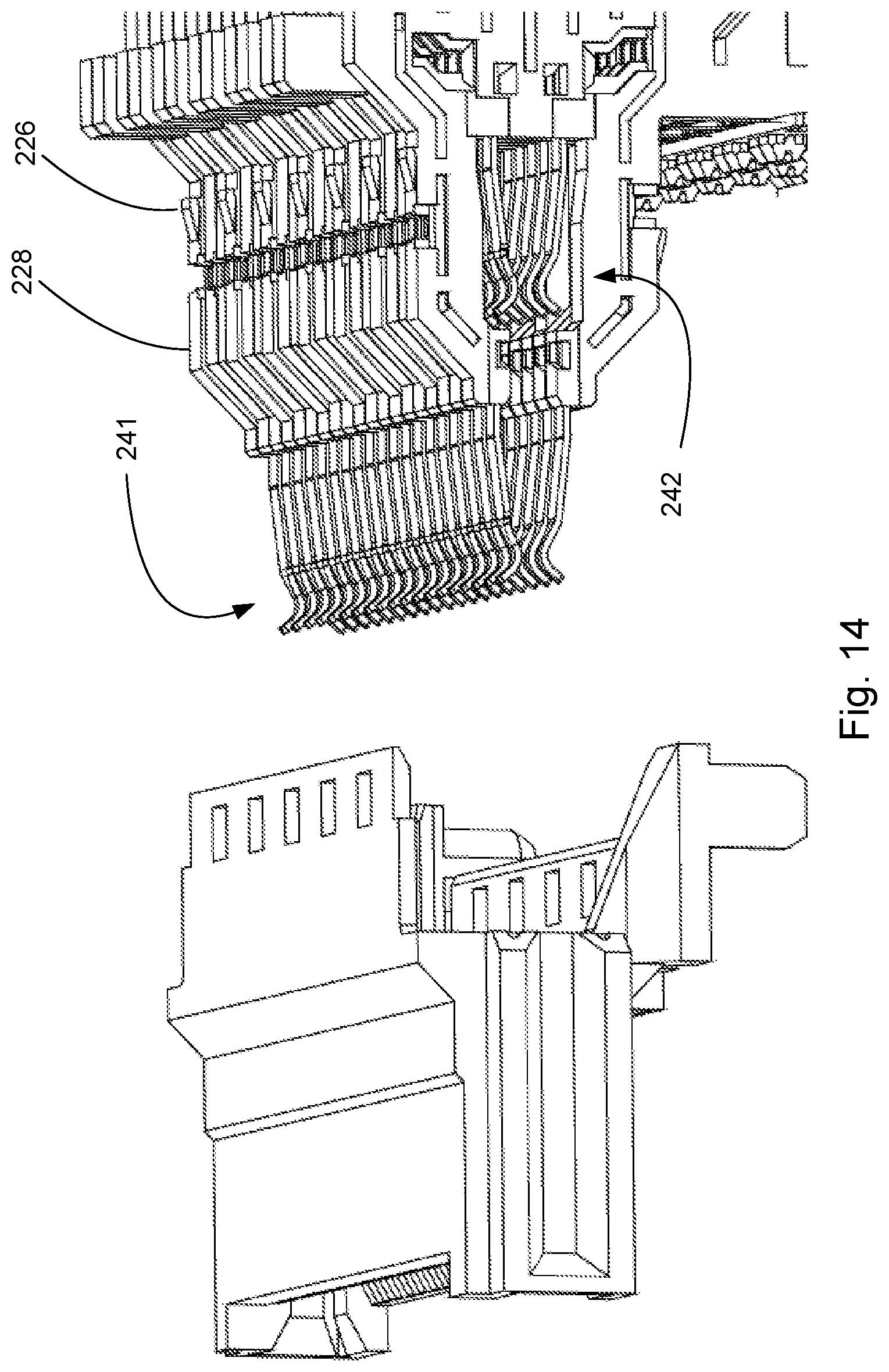
D00018
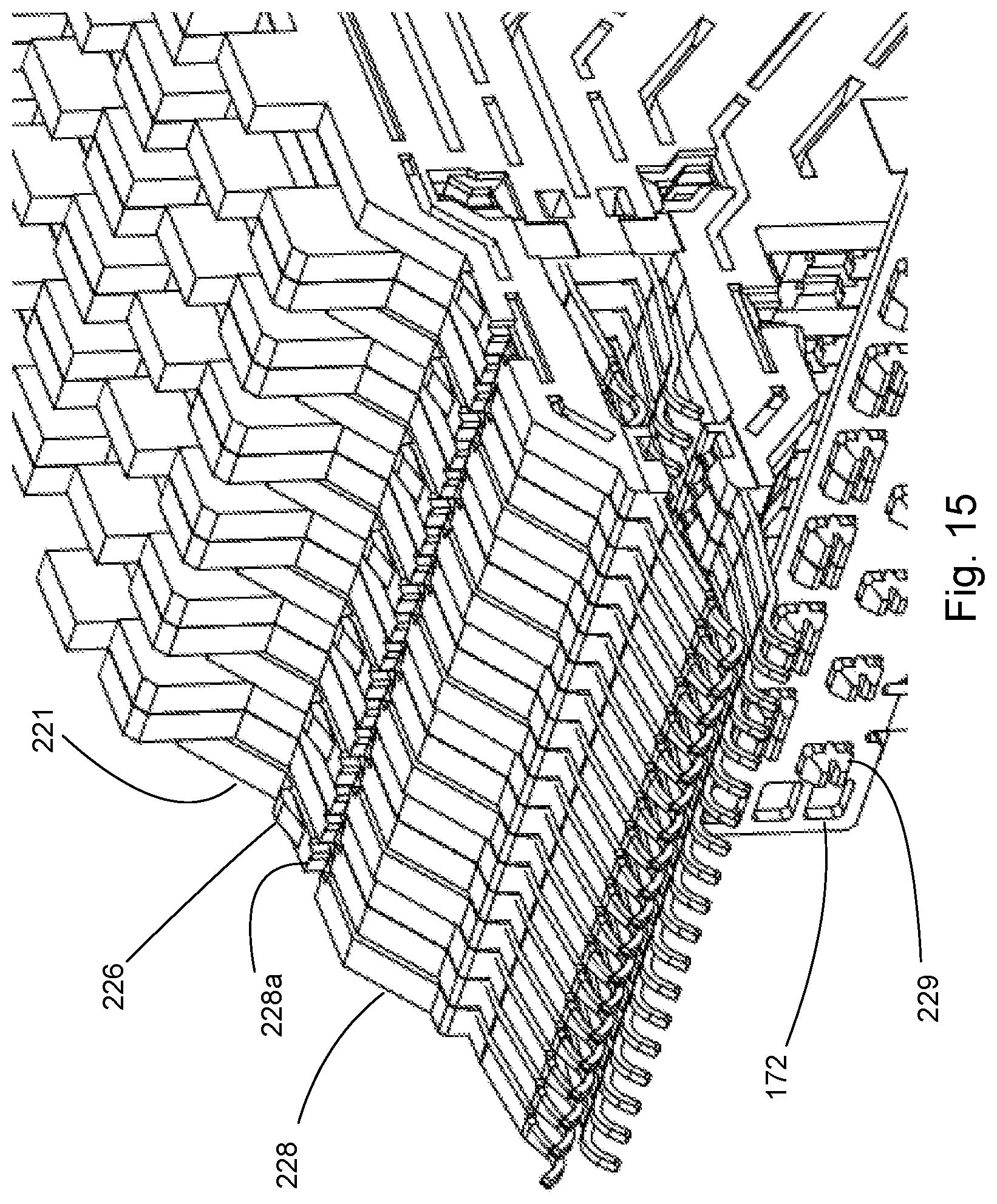
D00019
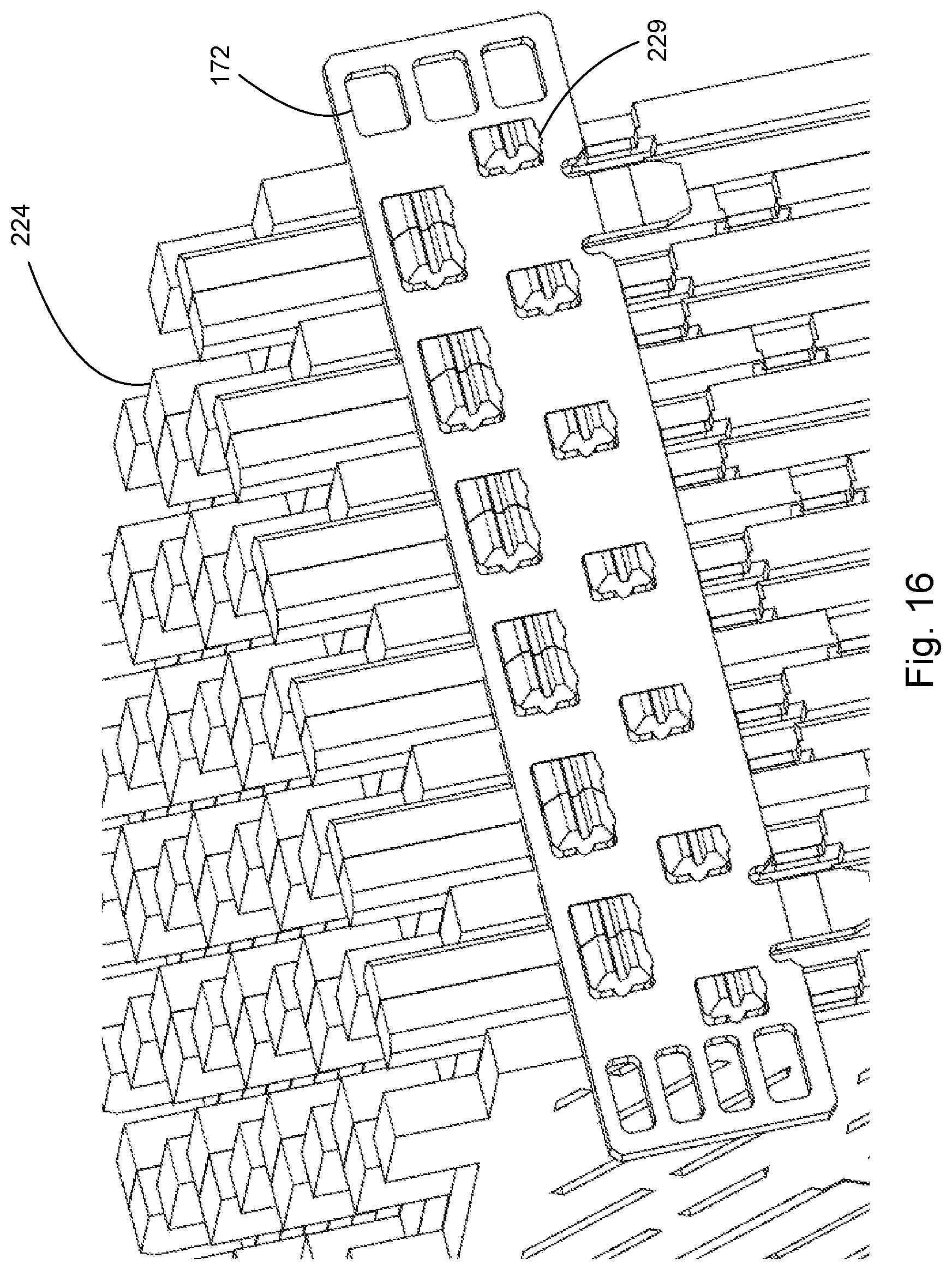
D00020
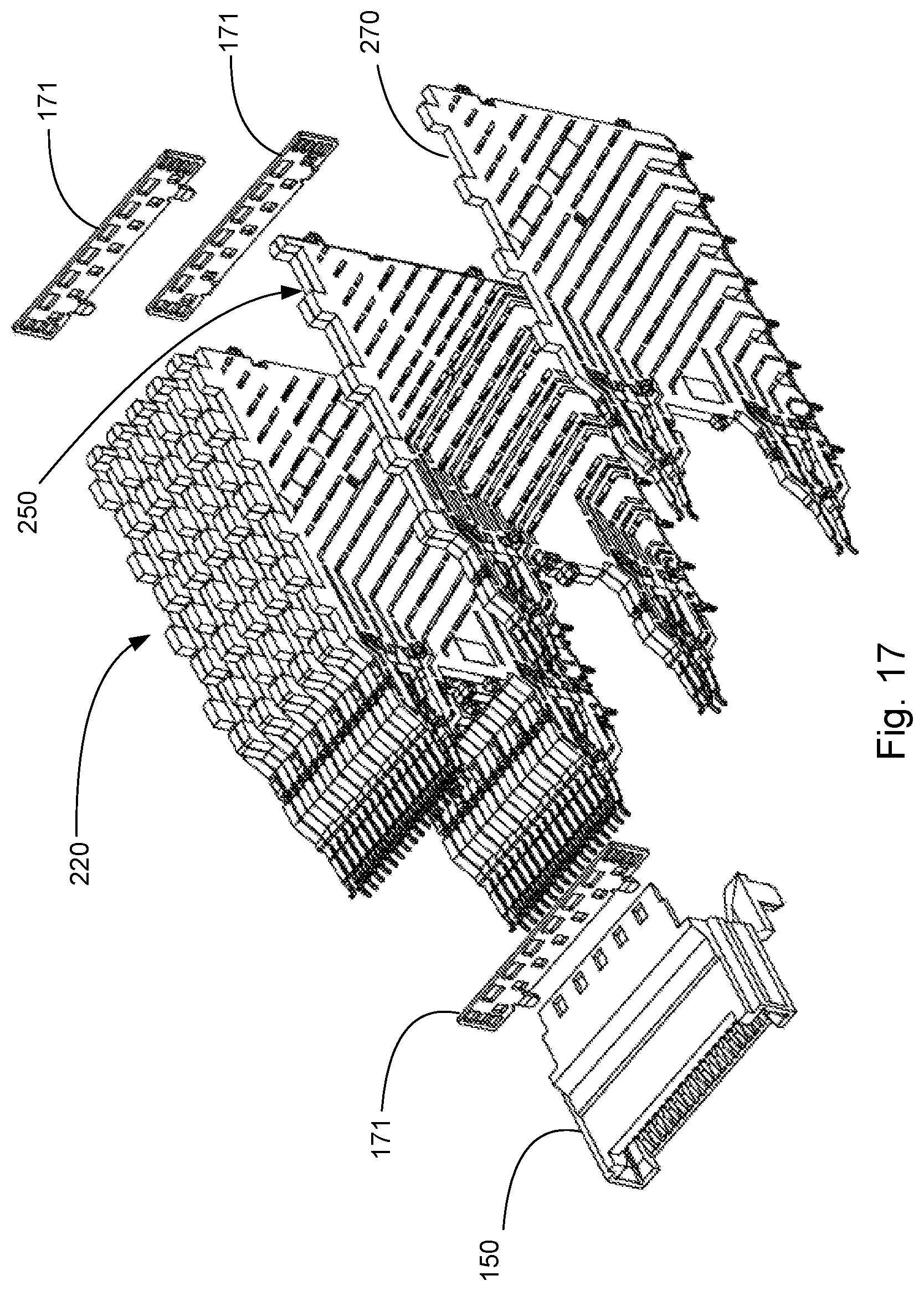
D00021
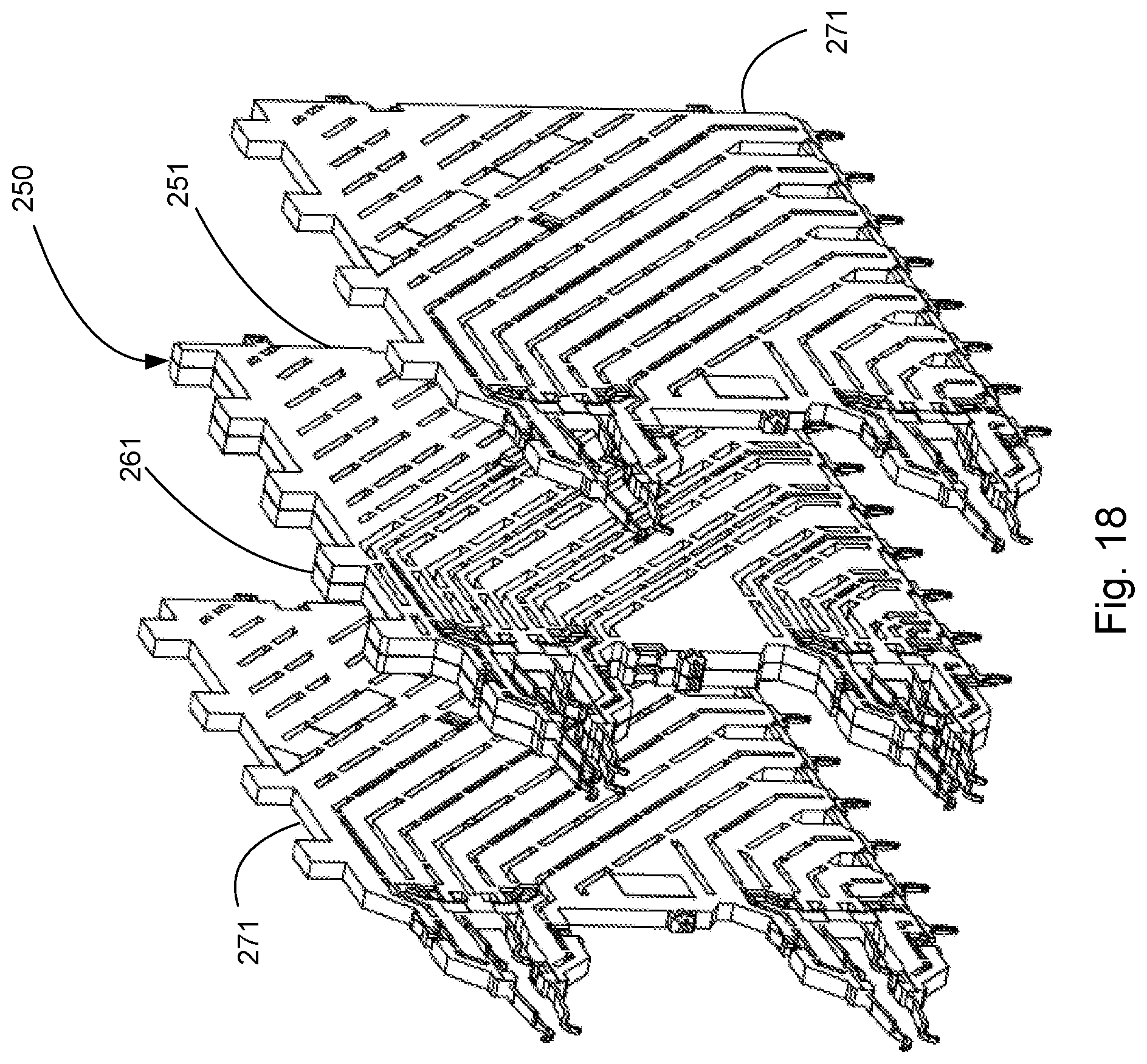
D00022
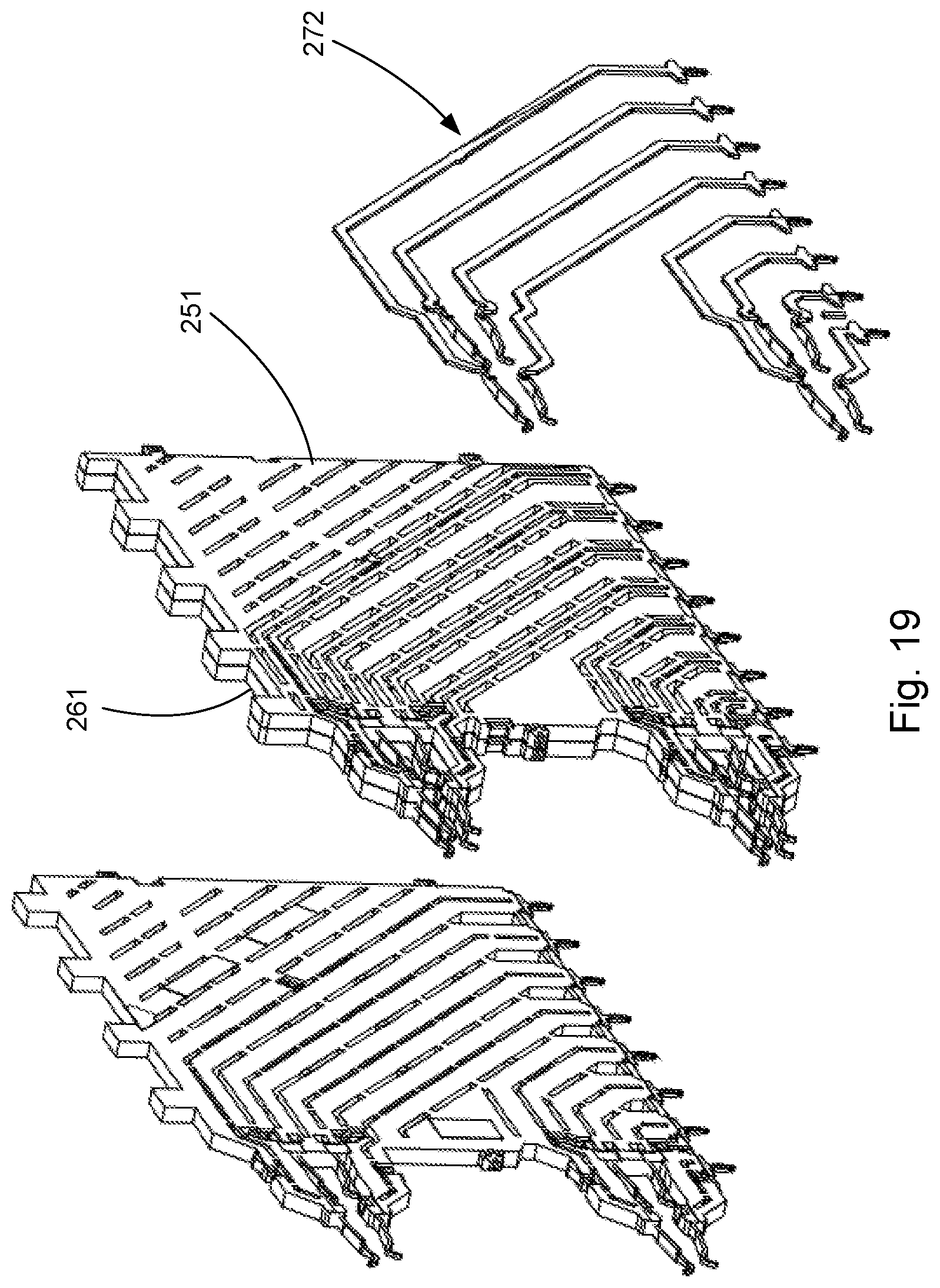
D00023
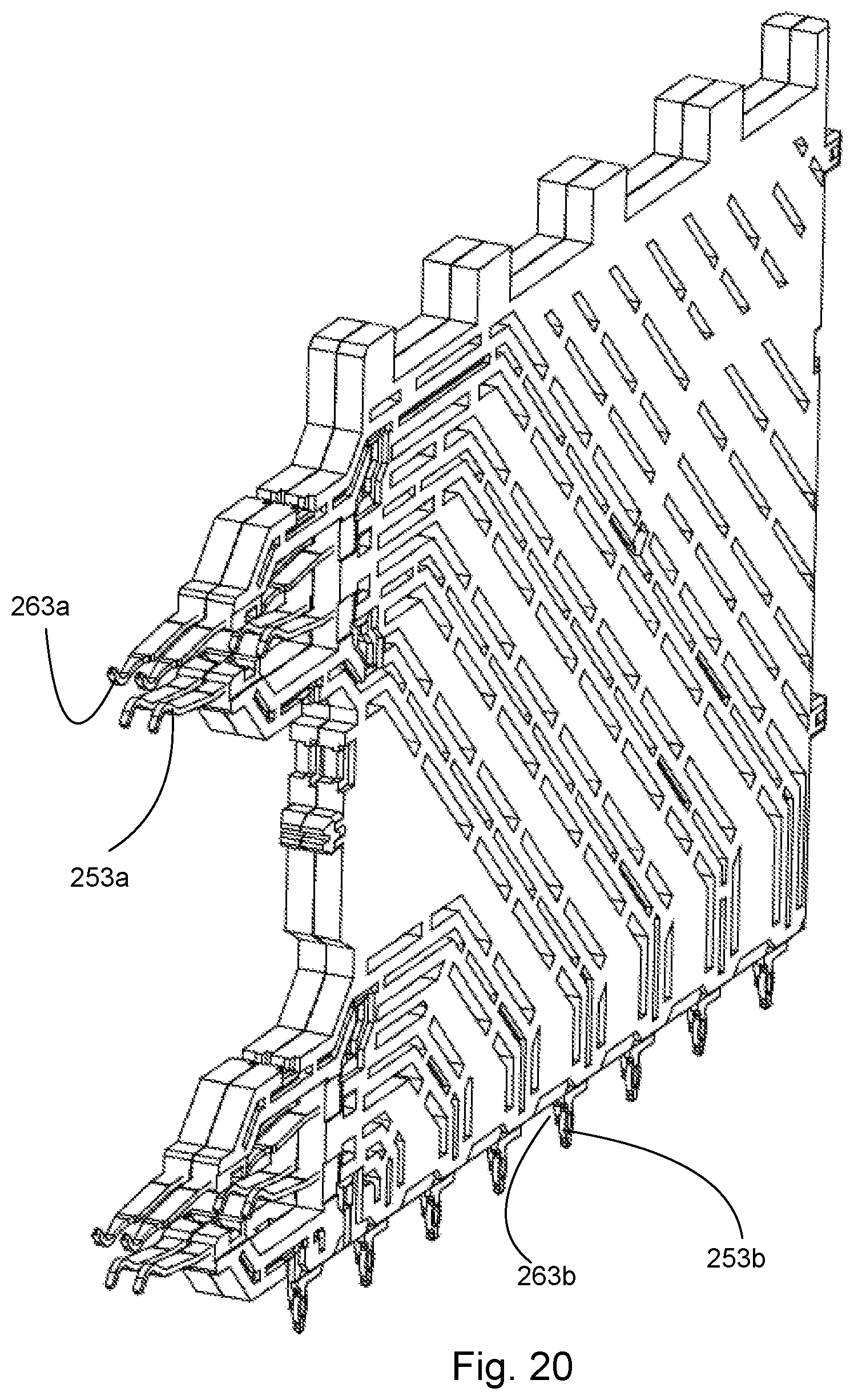
D00024
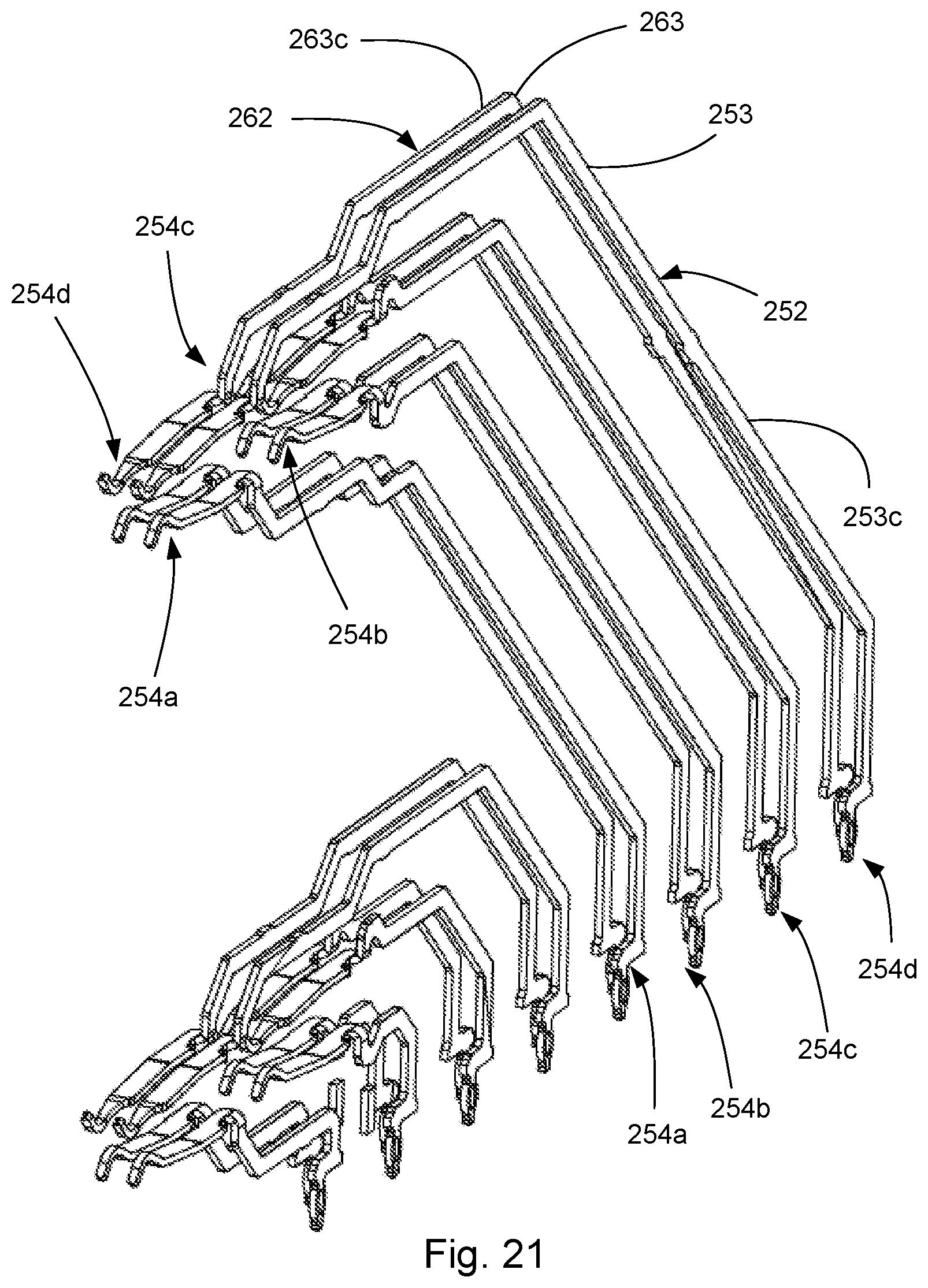
D00025
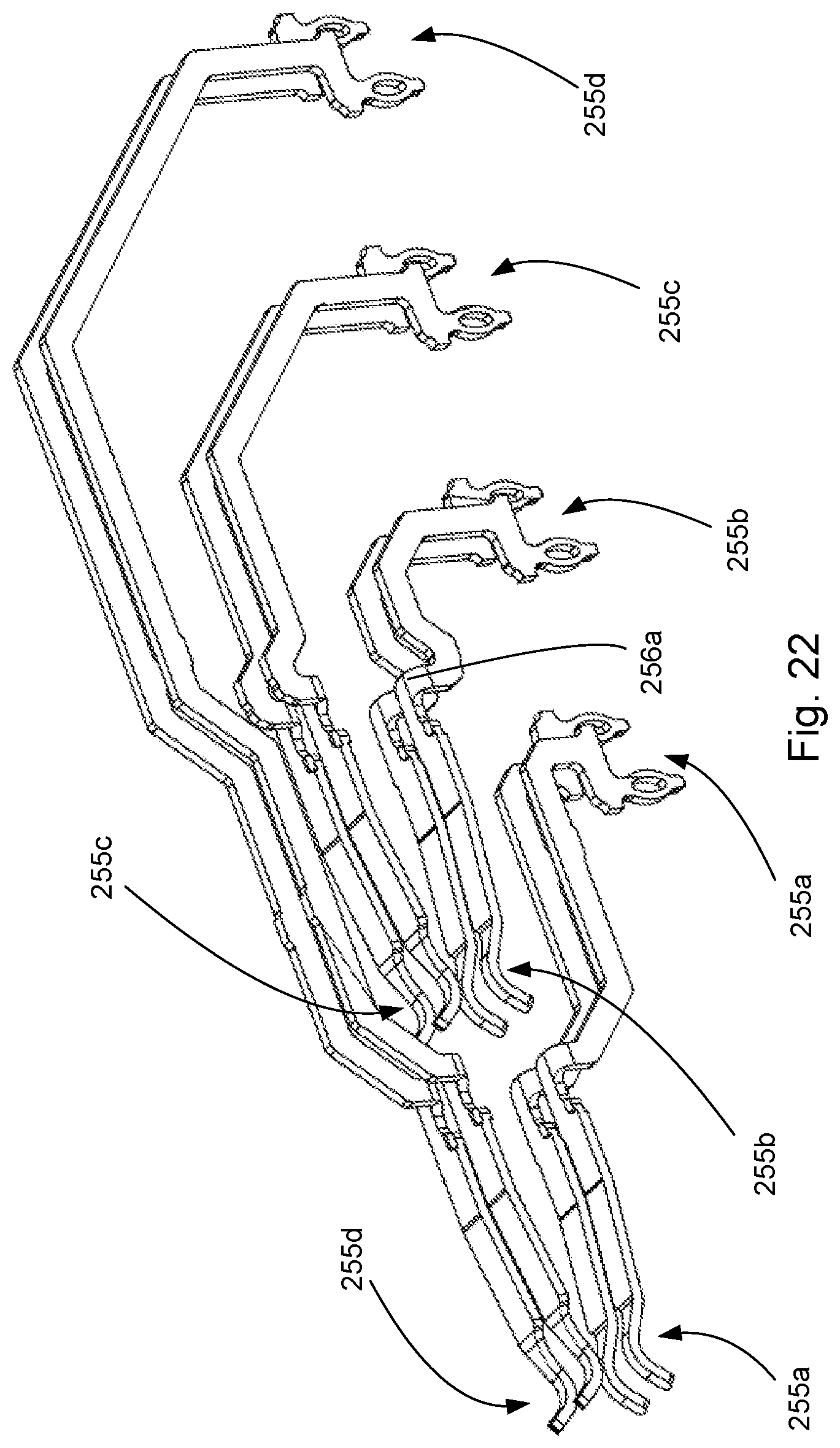
D00026
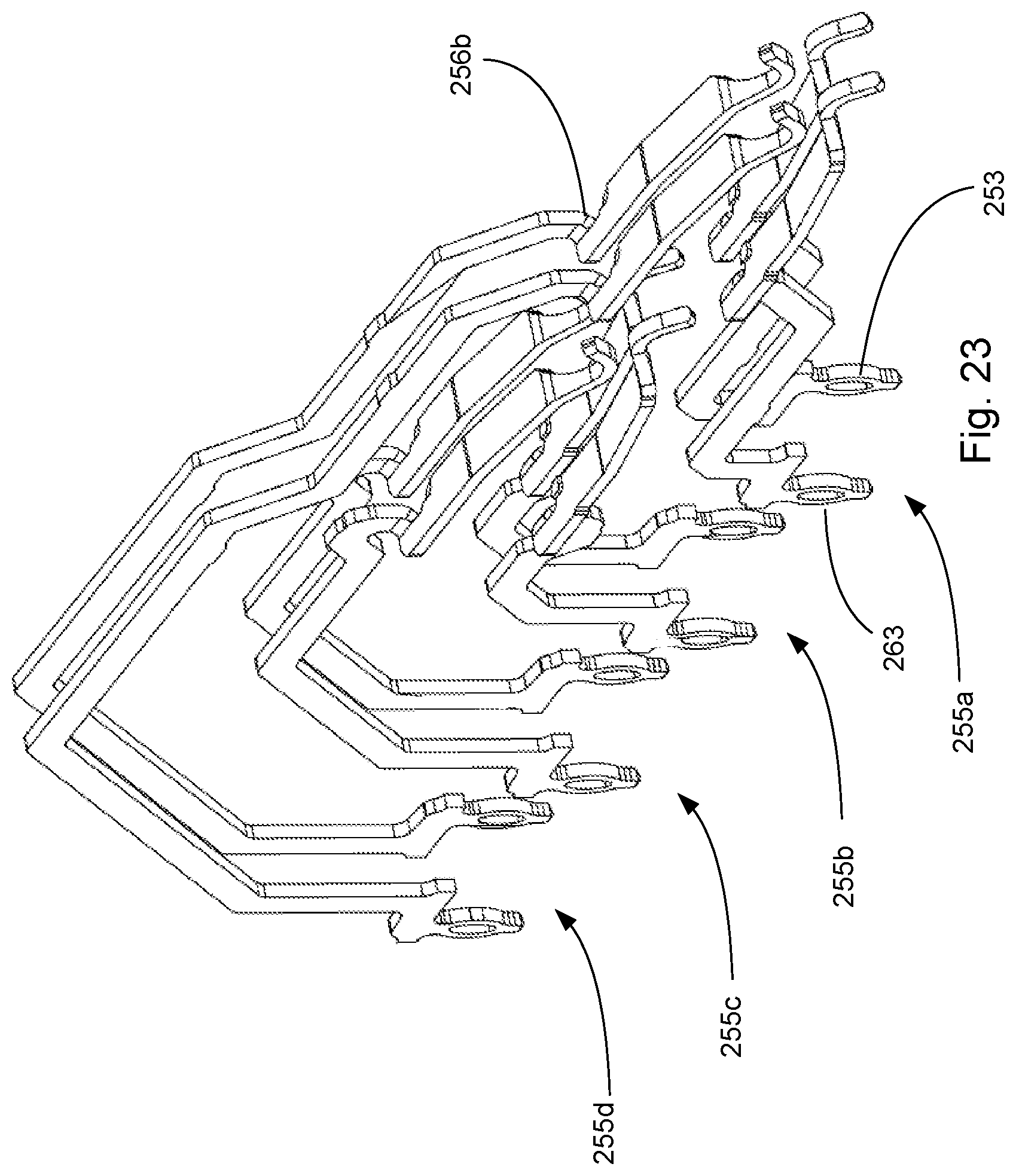
D00027
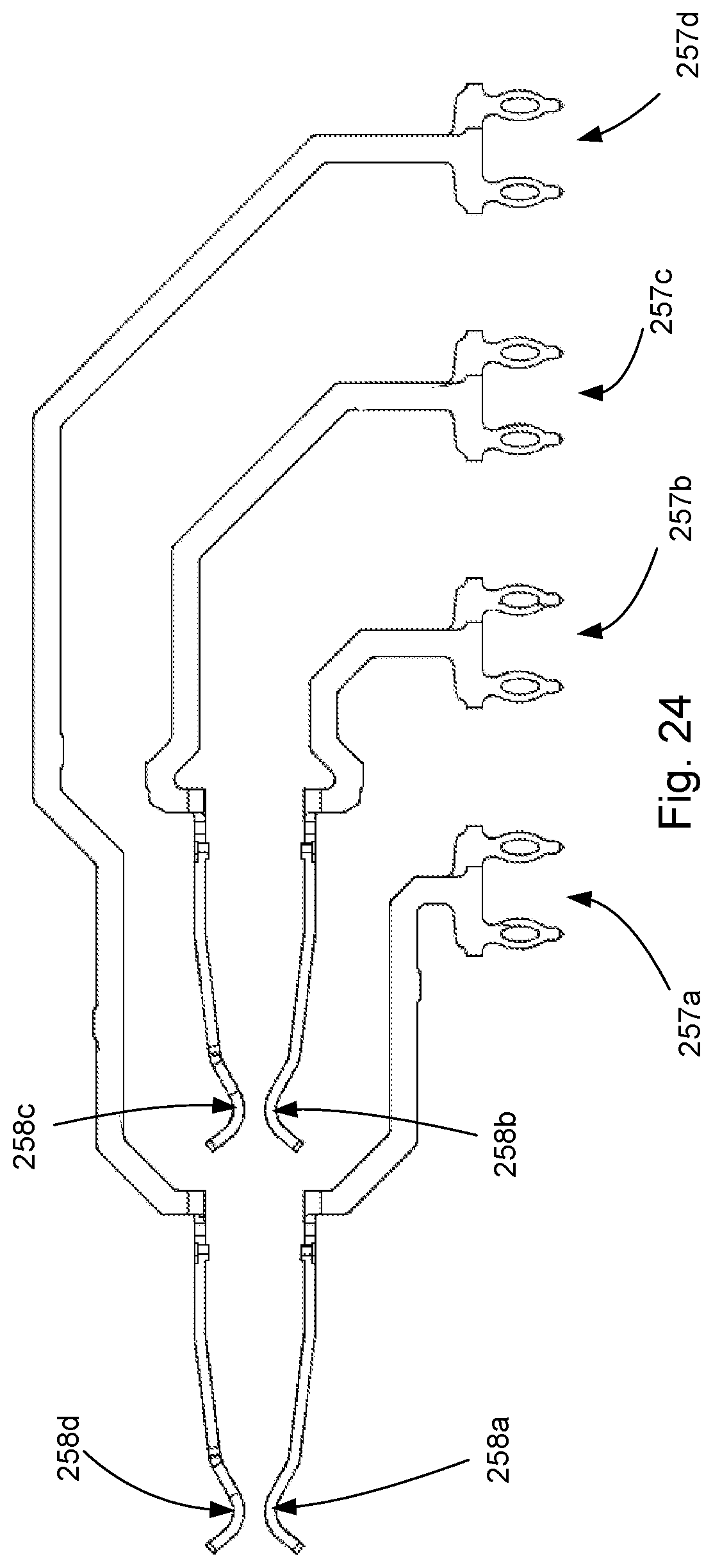
D00028
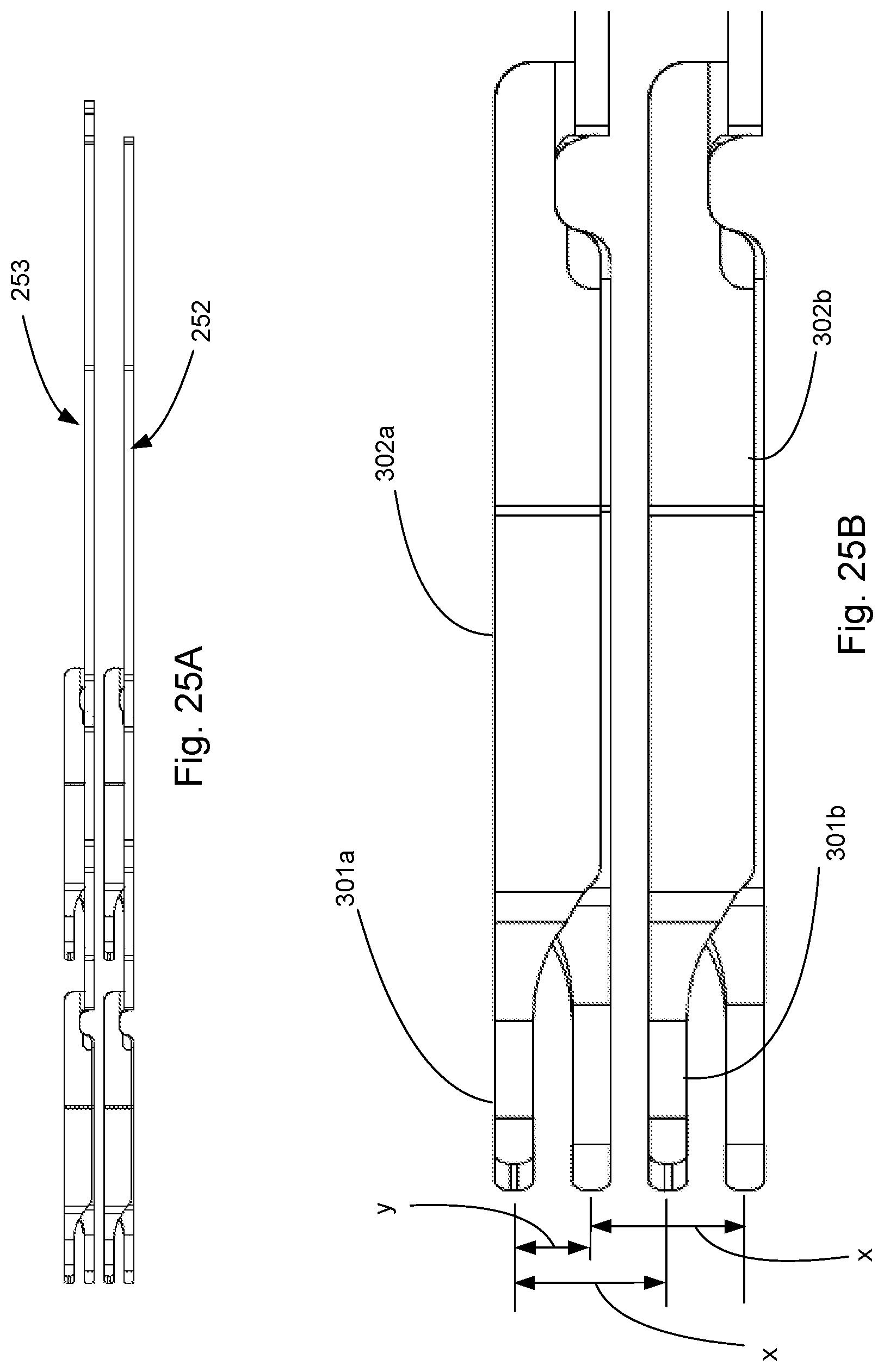
D00029
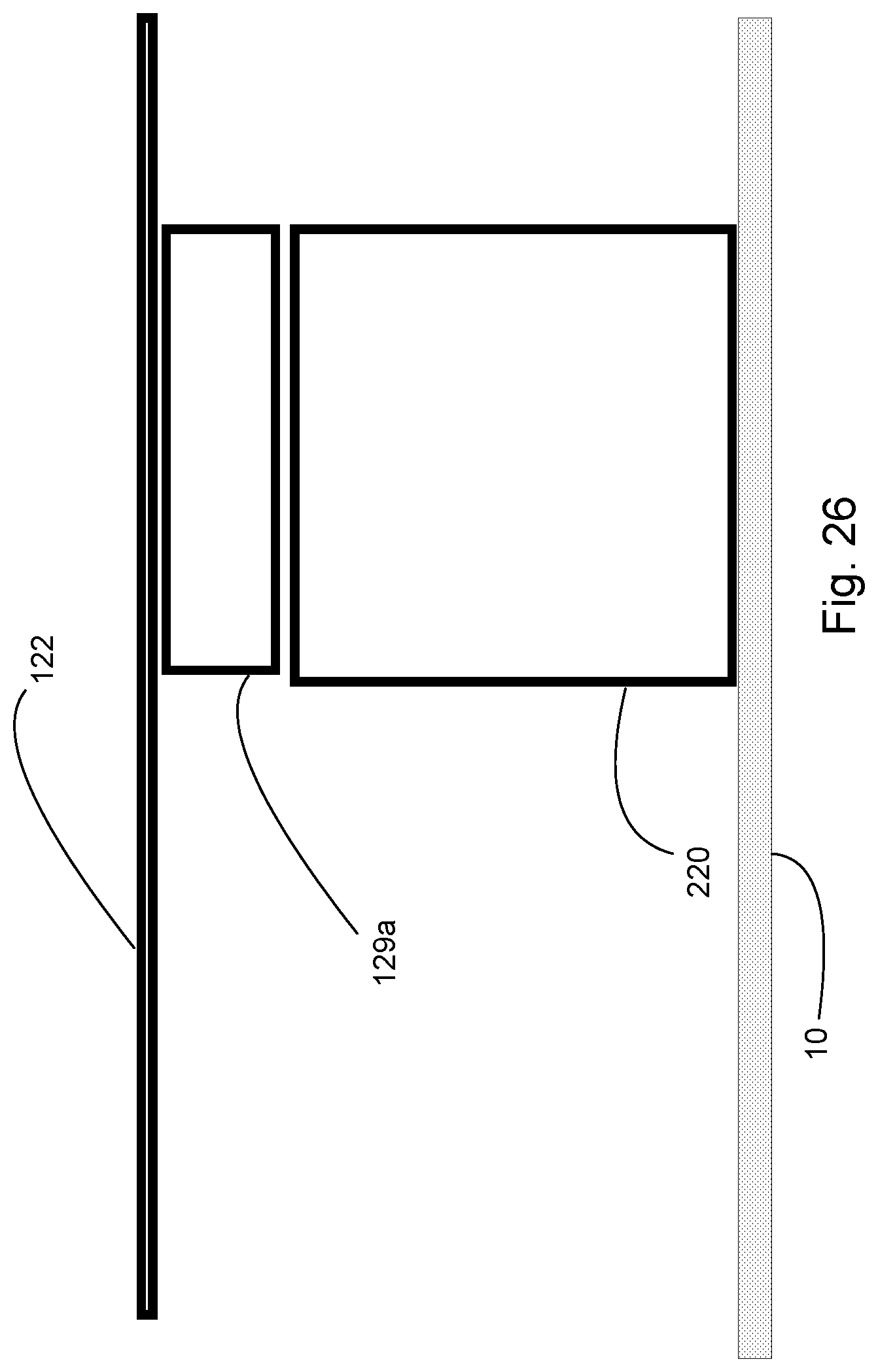
XML
uspto.report is an independent third-party trademark research tool that is not affiliated, endorsed, or sponsored by the United States Patent and Trademark Office (USPTO) or any other governmental organization. The information provided by uspto.report is based on publicly available data at the time of writing and is intended for informational purposes only.
While we strive to provide accurate and up-to-date information, we do not guarantee the accuracy, completeness, reliability, or suitability of the information displayed on this site. The use of this site is at your own risk. Any reliance you place on such information is therefore strictly at your own risk.
All official trademark data, including owner information, should be verified by visiting the official USPTO website at www.uspto.gov. This site is not intended to replace professional legal advice and should not be used as a substitute for consulting with a legal professional who is knowledgeable about trademark law.